Cheetah
The cheetah (Acinonyx jubatus; /ˈtʃiːtə/) is a large cat that occurs in Africa and central Iran. It is a lightly built, spotted cat with several adaptations for speed. It is characterised by a small rounded head, a short snout, black tear-like facial streaks, a deep chest, long thin legs and a long tail. Cheetahs typically reach 67–94 cm (26–37 in) at the shoulder, and the head-and-body length is between 1.1 and 1.5 m (3.6 and 4.9 ft). Adults typically weigh between 20 and 65 kg (44 and 143 lb). The coat is typically tawny to creamy white or pale buff and is mostly covered with evenly spaced, oval or round solid black spots. The cheetah is the fastest land animal. Estimates of the maximum speed vary from 80 to 128 km/h (50 to 80 mph); in 2012 a cheetah in Cincinnati Zoo made a world record by running 100 m (330 ft) in 5.95 seconds over a set run, during which she ran a recorded maximum speed of 98 km/h (61 mph). Four subspecies are recognised.
| Cheetah | |
|---|---|
_female_2.jpg) | |
| Female cheetah in KwaZulu Natal, South Africa | |
| Acoustic repertoire of cheetahs | |
| Scientific classification | |
| Kingdom: | Animalia |
| Phylum: | Chordata |
| Class: | Mammalia |
| Order: | Carnivora |
| Suborder: | Feliformia |
| Family: | Felidae |
| Subfamily: | Felinae |
| Genus: | Acinonyx |
| Species: | A. jubatus |
| Binomial name | |
| Acinonyx jubatus (Schreber, 1775) | |
| Subspecies | |
|
List
| |
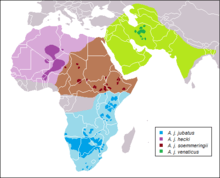 | |
| The range of the cheetah (2017)[3] | |
| Synonyms[4] | |
|
List
| |
More gregarious than many other cats, the cheetah has three main social groups—females and their cubs, male 'coalitions' and solitary males. While females lead a nomadic life searching for prey in large home ranges, males are more sedentary and may establish much smaller territories instead of ranges in areas with plentiful prey and access to females. The cheetah is active mainly during the day and hunting is the major activity, with peaks during dawn and dusk. It feeds on small- to medium-sized prey weighing mostly below 40 kg (88 lb), and prefers medium-sized ungulates such as impala, springbok and Thomson's gazelles. The cheetah will typically stalk its prey to within 60–70 m (200–230 ft), charge towards it, trip it during the chase and bite its throat to suffocate it to death. Breeding occurs throughout the year; after a gestational period of nearly three months a litter of typically three to five cubs is born; cheetah cubs are highly vulnerable to predation by other large carnivores such as hyenas and lions. Weaning happens at around four months, and cubs are independent by around 20 months of age.
The cheetah occurs in a variety of habitats such as savannahs in Serengeti, arid mountain ranges in the Sahara and hilly desert terrain in Iran. The cheetah is threatened by habitat loss, conflict with humans and poaching. Earlier ranging throughout most of Sub Saharan Africa and extending east through the Middle East up to the Indian subcontinent, the cheetah is now distributed in mainly small, fragmented populations in southern, eastern and northwestern Africa. It has been extirpated from most of its historical range in Asia, save for a population of less than 100 individuals in central Iran. In 2016 the global cheetah population was estimated at around 7,100 individuals in the wild; it is listed as Vulnerable by the IUCN. The cheetah has a long history of domestication by humans, primarily due to their hunting prowess. Cheetahs have been widely depicted in art, literature, advertising, and animation.
Etymology
The vernacular name 'cheetah' is derived from Hindustani, which today is split into Hindi: चीता (cītā) and Urdu: چیتا (chītā),[5] which in turn comes from Sanskrit: चित्रय (cītra) meaning variegated, adorned or painted.[6][7] The generic name Acinonyx probably derives from the combination of two Greek words: ἁκινητος (akinitos) meaning 'unmoved' or 'motionless', and ὄνυξ (onyx) meaning 'nail' or 'hoof'.[8] A rough translation would be 'immobile nails', a reference to the cheetah's limited ability to retract its claws.[9] A similar meaning can be obtained by the combination of the Greek prefix a– (implying lack of) and κῑνέω (kīnéō) meaning to move or set in motion.[10] A few old generic names such as Cynailurus and Cynofelis allude to the similarities between the cheetah and canids.[11] The specific name jubatus is Latin for 'crested', in reference to the long hair on the nape.[12]
Taxonomy

In 1777, German naturalist Johann Christian Daniel von Schreber described the cheetah on the basis of a skin from the Cape of Good Hope and gave it the scientific name Felis jubatus.[13] In 1828, British naturalist Joshua Brookes placed the cheetah in a genus of its own, Acinonyx.[14] The striking morphological resemblance between the cheetah and the greyhound, coupled with significant deviation from typical felid features, led British zoologist Reginald Innes Pocock to place the cheetah in a subfamily of its own, Acinonychinae; the cheetah was classified in Felinae in later taxonomic revisions.[15] In the 19th and 20th centuries, several cheetah specimens were described; some were proposed as subspecies. An example is the South African specimen known as the "woolly cheetah", named for its notably dense fur—this was described as a new species (Felis lanea) by English zoologist Philip Sclater,[16] but the classification was mostly disputed.[17]
Texts on the natural history of India from the time of the British Raj are often ambiguous on the nomenclature of cheetahs and leopards (Panthera pardus). There are mentions of the 'hunting leopard' (often referred to as Felis jubata in the texts), a species separate from cheetahs and leopards; Indian cheetahs were typically referred to as F. venatica, based on a description by British zoologist Edward Griffith in 1821.[18] British scientific lecturer Charles Frederick Partington noted that the hunting leopard ranged from Africa westward till southwestern Asia, beyond which it was replaced by the cheetah (F. venatica). He noted very few differences between the hunting leopard and the Indian cheetah, mainly that the coat of the hunting leopard was of a deeper shade and the hair on the neck and cheeks was thicker.[19] Several records refer to Indian cheetahs as "hunting leopards", due to their prevalent use as hunting companions.[20] Some authors proposed classifying cheetahs as leopards,[21] while some equated the hunting leopard to the leopard.[22]
Subspecies
In 1975, Reay H. N. Smithers (of the Ditsong National Museum of Natural History) identified five valid cheetah subspecies: A. j. hecki, A. j. jubatus, A. j. raineyi, A. j. soemmeringii and A. j. venaticus.[3] A 2011 phylogeographic study found minimal genetic variation between A. j. jubatus and A. j. raineyi; only four subspecies could be identified.[23] In 2017, the Cat Classification Task Force of the IUCN Cat Specialist Group revised felid taxonomy and recognized these four subspecies as valid. Their details are tabulated below:[3][24]
| Subspecies | Details | Image |
|---|---|---|
| Southeast African cheetah (A. j. jubatus) (Schreber, 1775), syn. A. j. raineyi Heller, 1913 | It was first described by Schreber in 1777, and is therefore the nominate subspecies.[24] A. j. raineyi, which was a specimen from Kapiti Plains (Kenya) described by American zoologist Edmund Heller in 1913,[25] is treated as a synonym for this subspecies.[3] Earlier distributed throughout southern Africa with the exception of the desert area on the western coast of modern-day Angola and Namibia, this cheetah now occurs in much smaller and fragmented populations due to increasing changes to its natural habitat. As of 2016, the largest population (nearly 4,000 individuals) is sparsely distributed over Angola, Botswana, Mozambique, Namibia, South Africa and Zambia. It was reintroduced in Malawi in 2017.[26] This subspecies is estimated to have diverged from the Asiatic cheetah 32,000 to 67,000 years ago.[23] | .jpg) |
| Asiatic cheetah (A. j. venaticus) Griffith, 1821 | This subspecies is confined to the central deserts of Iran, and is the only surviving cheetah population in Asia.[27] It was first described by British zoologist Edward Griffith in 1821 as Felis venatica.[18] In the past the Asiatic cheetah occurred throughout middle Asia, from the Arabian Peninsula to the Indian subcontinent.[28] Previously distributed throughout arid areas and steppes in eastern Iran, the range has contracted to a few pockets and the numbers have plummeted in the years following the Iranian Revolution (1979).[29] Per an estimate in 2016, only 43 individuals were recorded in three subpopulations scattered over less than 150,000 km2 (58,000 sq mi) in Iran's central plateau.[30] The IUCN has classified this cheetah as Critically Endangered.[31] | _05.jpg) |
| Northeast African cheetah (A. j. soemmeringii) Fitzinger, 1855 | This subspecies occurs in northern Central African Republic (CAR), Chad, Ethiopia and South Sudan. Little is known about its occurrence in Somalia; it may be present in the Lag Badana National Park and the Nugaal Valley.[27] It was first described by Austrian zoologist Leopold Fitzinger in 1855 as Cynailurus soemmeringii.[32] Populations are small and heavily fragmented—in 2017 the population in northern CAR and southeastern Chad was estimated at 238 individuals, distributed mainly over unprotected areas.[27] This cheetah is part of captive breeding programs such as the European Endangered Species Programme (EEP) of the European Association of Zoos and Aquaria (EAZA).[33] This subspecies is estimated to have diverged from the Southeast African cheetah 16,000 to 72,000 years ago.[23] | 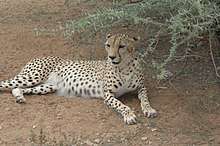 |
| Northwest African cheetah (A. j. hecki) Hilzheimer, 1913 | This subspecies occurs in Northwestern Africa including Algeria, Benin, Burkina Faso and Niger.[34] It was first described by German zoologist Max Hilzheimer in 1913.[35] Small populations are known to exist in the Ahaggar and Tassili N'Ajjer National Parks in southern Algeria.[36][37] In Niger, cheetahs have been recorded in the Aïr Mountains, Azawagh valley, Talak, Ténéré and Termit Massif. In Benin, the cheetah occurs in Pendjari National Park and W National Park. The status is obscure in Burkina Faso, where individuals may be confined to the southeastern region. With the total population estimated at less than 250 mature individuals in 2008, the IUCN has listed this cheetah as Critically Endangered.[34] In 2017, the cheetah population in Adrar des Ifoghas, Ahaggar, Tassili n'Ajjer (covering south-central Algeria) and northeastern Mali was estimated at 191 individuals; 25 cheetahs were recorded in the W-Arly-Pendjari Complex, and merely three were recorded in the Aïr, Ténéré and Termit regions.[27] | 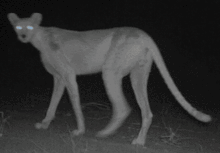 |
Phylogeny and evolution
| ||||||||||||||||||||||||||||||||||||||||||||||||||||
| The Puma lineage of the family Felidae, depicted along with closely related genera.[38] |
The cheetah's closest relatives are the cougar (Puma concolor) and the jaguarundi (Herpailurus yagouaroundi).[3] These three species together form the Puma lineage, one of the eight lineages of Felidae; the Puma lineage diverged from the rest 6.7 mya. The sister group of the Puma lineage is a clade of smaller Old World cats that includes the genera Felis, Otocolobus and Prionailurus.[38]
The oldest Acinonyx fossils, excavated in eastern and southern Africa, date to 3.5–3 mya; the earliest known specimen from South Africa is from the lowermost deposits of the Silderberg Grotto (Sterkfontein).[4][10] Though incomplete, these fossils indicate forms larger but less cursorial than the modern cheetah.[39] Fossil remains from Europe are limited to a few Middle Pleistocene specimens from Hundsheim (Austria) and Mosbach Sands (Germany).[40] Cheetah-like cats are known from as late as 10,000 years ago from the Old World. The giant cheetah (A. pardinensis), significantly larger and slower compared to the modern cheetah, occurred in Eurasia and eastern and southern Africa in the Villafranchian period (roughly 3.8–1.9 mya).[41][15] This cheetah was significantly heavier, weighing 60 to 121 kg (132 to 267 lb), and the teeth were not very specialised for tearing meat.[39] Similar forms are known from India and China.[38] In the Middle Pleistocene a smaller cheetah, A. intermedius, ranged from Europe to China.[4] Other Old World fossil cheetahs include A. aicha from Casablanca (Morocco);[42] a specimen from China (A. kurteni), reportedly the oldest member of the genus, was later found out to be a composite specimen.[43] The modern cheetah appeared in Africa around 1.9 mya; its fossil record is restricted to Africa.[39]
Extinct North American cheetah-like cats had historically been classified in Felis, Puma or Acinonyx; two such species, Felis studeri and F. trumani, were considered to be closer to the puma than the cheetah despite their close similarities to the latter. In 1979, palaeontologist Daniel Adams pointed out that such extensive resemblance in several factors could not be simply attributed to parallel evolution. He proposed a new subgenus under Acinonyx, Miracinonyx, for the North American cheetah-like cats. Moreover, he noted that North American and Old World cheetah-like cats may have had a common ancestor, implying North America as the true place of origin of the cheetah instead of Eurasia.[44] A 1990 cladistic study suggested the differences between Acinonyx and Miracinonyx were more on a generic level, and elevated Miracinonyx to genus rank.[45][46] Miracinonyx species greatly resembled modern cheetahs; both Acinonyx and Miracinonyx developed features such as a reduced head mass and a wider nasal passage that could have facilitated oxygen inhalation and remarkably improved the speed and length of runs.[15]:33–34 However, subsequent research has shown that Miracinonyx is phylogenetically closer to the cougar than the cheetah.[47] The similarities were attributed to convergent evolution in response to similar environmental stimuli; for instance, it is possible that Miracinonyx species were adapted to prey on pronghorns, which appear to have evolved traits similar to those of Old World gazelles, which Old World cheetah-like cats preyed on.[38]
The three species of the Puma lineage may have had a common ancestor during the Miocene (roughly 8.25 mya).[44][48] North American cheetahs possibly migrated to Asia via the Bering Strait, then dispersed southward to Africa through Eurasia at least 100,000 years ago;[49][50][51] some authors have expressed doubt over the occurrence of cheetah-like cats in North America, and instead suppose the modern cheetah to have evolved from Asian populations that eventually spread to Africa.[47][52] Cheetahs are believed to have experienced two population bottlenecks that greatly lowered the genetic variability in populations – one 100,000 years ago coinciding with the migration from North America to Asia, and the second 10,000–12,000 years ago in Africa due to the Late Pleistocene extinction.[50][53][54]
Genetics
The diploid number of chromosomes in the cheetah is 38, the same as in most other felids.[28] The cheetah was the first felid observed to have unusually low genetic variability among individuals.[55]:115 Consequences of such extensive genetic similarity include poor breeding in captivity, increased spermatozoal defects, high juvenile mortality and increased susceptibility to diseases and infections.[56][57] A prominent instance was the deadly feline coronavirus outbreak in a cheetah breeding facility of Oregon in 1983 which had a mortality rate of 60% – higher than that recorded for previous epizootics of feline infectious peritonitis in any felid.[58] The remarkable homogeneity in cheetah genes has been demonstrated by experiments involving the major histocompatibility complex (MHC); unless the MHC genes are highly homogeneous in a population, skin grafts exchanged between a pair of unrelated individuals would be rejected. Skin grafts exchanged between unrelated cheetahs are accepted well and heal, as if their genetic makeup were the same.[59][60] Cheetah expert Laurie Marker points out that the high level of genetic uniformity would mean that if an infectious disease surfaced in a population, all of them have (or lack) the same level of immunity.[61]
King cheetah
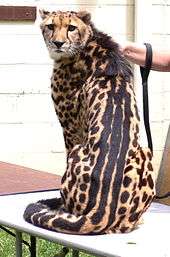
The king cheetah is a variety of cheetah with a rare mutation for cream-coloured fur marked with large, blotchy spots and three dark, wide stripes extending from the neck to the tail.[62] In 1926 Major A. Cooper wrote about an animal he had shot near modern-day Harare. He noted its remarkable similarity to the cheetah, but the body was covered with fur as thick as that of a snow leopard and the spots merged to form stripes. He suggested it could be a cross between a leopard and a cheetah. As more such individuals were observed, it was established that they had non-retractable claws – a characteristic feature of the cheetah.[63][64]
Pocock described these individuals as a new species by the name of Acinonyx rex ('rex' being Latin for 'king', the name translates to 'king cheetah').[64] However, in absence of proof to support his claim, he withdrew his proposal in 1939. English naturalist Abel Chapman considered it a colour morph of the normally spotted cheetah.[65][66] Since 1927 the king cheetah has been reported five more times in the wild; one was photographed in 1975.[67]
King cheetahs have been reported from Zimbabwe, Botswana and northern Transvaal. In 1981 two female cheetahs at the De Wildt Cheetah and Wildlife Centre (South Africa) gave birth to one king cheetah each; either female had mated with a wild male from Transvaal. Subsequently, more king cheetahs were born at the Centre.[65] In 2012 the cause of this alternative coat pattern was found to be a mutation in the gene for transmembrane aminopeptidase Q (Taqpep), the same gene responsible for the striped "mackerel" versus blotchy "classic" pattern seen in tabby cats.[68][69] The appearance is caused by reinforcement of a recessive allele. As a result, if two mating cheetahs carry the mutated allele, then a quarter of their offspring can be expected to be king cheetahs.[70]
Characteristics
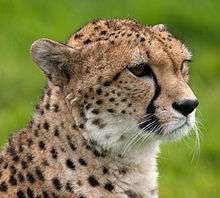
The cheetah is a lightly built, spotted cat characterised by a small rounded head, a short snout, black tear-like facial streaks, a deep chest, long thin legs and a long tail. Its slender, canine form is highly adapted for speed, and contrasts sharply with the robust build of the big cats (genus Panthera).[11][71] Cheetahs typically reach 67–94 cm (26–37 in) at the shoulder, and the head-and-body length is between 1.1 and 1.5 m (3.6 and 4.9 ft).[10][72][73] The weight can vary with age, health, location, sex and subspecies; adults typically range between 20 and 65 kg (44 and 143 lb). Cubs born in the wild weigh 150–300 g (5.3–10.6 oz) at birth, while those born in captivity tend to be larger and weigh around 500 g (18 oz); the weight keeps increasing till the cheetah turns four to six years old.[11][70][72] The largest cheetahs occur in southern Africa, and are only slightly bigger than eastern African cheetahs. Saharan cheetahs show particularly canine facial features, and feature chocolate brown spots on a pale coat.[74] Cheetahs are sexually dimorphic, with males larger and heavier than females, but not to the extent seen in other large cats.[73][75][76]
The coat is typically tawny to creamy white or pale buff (darker in the mid-back portion).[10][72] The chin, throat and underparts of the legs and the belly are white and devoid of markings. The rest of the body is covered with around 2,000 evenly spaced, oval or round solid black spots, each measuring roughly 3–5 cm (1.2–2.0 in).[70][74][77] Each cheetah has a distinct pattern of spots that can be used to uniquely identify individuals.[73] Besides the clearly visible spots, there are other faint, irregular black marks on the coat.[74] Newly born cubs are covered in fur with an unclear pattern of spots that gives them a dark appearance – pale white above and nearly black on the underside.[11] The hair is mostly short and often coarse, but the chest and the belly are covered in soft fur; the fur of king cheetahs has been reported to be silky.[10][78] There is a short, rough mane, covering at least 8 cm (3.1 in) along the neck and the shoulders; this feature is more prominent in males. The mane starts out as a cape of long, loose blue to grey hair in juveniles.[70][78] Melanistic cheetahs have been observed in Zambia and Zimbabwe.[74] In 1877–1878, Philip Sclater described two partially albino specimens from South Africa.[70] A tabby cheetah was photographed in Kenya in 2012.[79]
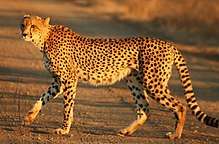
The head is small and more rounded compared to other big cats.[80] The ears are small, short and rounded; they are tawny at the base and on the edges and marked with black patches on the back. The eyes are set high and have round pupils.[73] The whiskers, shorter and fewer than those of other felids, are fine and inconspicuous.[81] The pronounced malar stripes or "tear streaks", unique to the cheetah, originate from the corners of the eyes and run down the nose to the mouth. The role of these streaks is not well understood – they may protect the eyes from the sun's glare (a helpful feature as the cheetah hunts mainly during the day), or they could be used to define facial expressions.[74] The exceptionally long and muscular tail, with a bushy white tuft at the end, measures 60–80 cm (24–31 in).[82] While the first two-thirds of the tail are covered in spots, the final part is marked with four to six dark rings or stripes.[70][77] The arrangement of the terminal stripes of the tail differs among individuals, but the stripe patterns of siblings tend to be similar. In fact, the tail of an individual will typically resemble its siblings' to a greater extent than that of its mother or any other individual.[70]
The cheetah can be easily confused with the leopard, but the leopard has rosettes instead of spots[83] and lacks tear streaks.[75] Moreover, the cheetah is slightly taller than the leopard. The serval resembles the cheetah in physical build, but is significantly smaller, has a shorter tail and its spots fuse to form stripes on the back.[84]
Anatomy
.jpg)
Sharply contrasting with the big cats in its morphology, the cheetah shows several adaptations for prolonged chases to catch prey at some of the fastest recorded speeds.[85] Its light, streamlined body makes it well-suited to short, explosive bursts of speed, rapid acceleration, and an ability to execute extreme changes in direction while moving at high speed; this athleticism is critical to the cat's predatory success rate.[86][87][88] The large nasal passages, accommodated well due to the smaller size of the canine teeth, ensure fast flow of sufficient air, and the enlarged heart and lungs allow the enrichment of blood with oxygen in a short time. This allows cheetahs to rapidly regain their stamina after a chase.[4][70] During a typical chase, their respiratory rate increases from 60 to 150 breaths per minute.[89] Moreover, the reduced viscosity of the blood at higher temperatures (common in frequently moving muscles) could ease blood flow and increase oxygen transport.[90] While running, in addition to having good traction due to their semi-retractable claws, cheetahs use their tail as a rudder-like means of steering that enables them to make sharp turns, necessary to outflank antelopes that often change direction to escape during a chase.[70][80] The protracted claws increase grip over the ground, while foot pads make the sprint more convenient over tough ground. The limbs of the cheetah are longer than what is typical for its size; the thigh muscles are large, and the tibia and fibula bones are held close together making the lower legs are less likely to rotate. This reduces the risk losing balance during runs, but compromises the ability to climb. The highly reduced clavicle is connected through ligaments to the scapula, whose pendulum-like motion increases the stride length and assists in shock absorption. The extension of the vertebral column can add as much as 76 cm (30 in) to the length of a stride.[91][92]
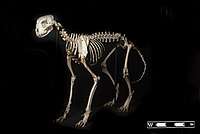
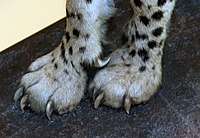
The cheetah resembles the smaller cats in cranial features and in having a long and flexible spine, as opposed to the stiff and short one in other large felids.[4] In the Puma lineage, both the cheetah and the puma have short, wide skulls unlike the jaguarundi.[93] The face and the jaw are unusually shortened and the wide, dome-like forehead is set high. The roughly triangular skull has light, narrow bones and the sagittal crest is poorly developed, possibly to reduce weight and enhance speed. The mouth can not be opened as widely as in other cats given the shorter length of muscles between the jaw and the skull.[70][75] Males have slightly bigger skulls with wider incisors and longer mandibles than do females.[4] A study of felid morphology indicated that the starkly different morphology of the cheetah might result from the early truncation of the development of the middle phalanx bone compared to other felids.[85] The cheetah appears to show convergent evolution with canids in morphology as well as behaviour; it has canine features such as a relatively long snout, long legs, a deep chest, tough foot pads and blunt, semi-retractable claws. Even the hunting behaviour of cheetahs resembles that of canids.[94][95] The cheetah has often been likened to the greyhound, as both have similar morphology and the ability to reach tremendous speeds in a shorter time than other mammals,[78][82] but the cheetah can attain higher maximum speeds.[96]
The cheetah has a total of 30 teeth; the dental formula is 3.1.3.13.1.2.1. The deciduous dentition is 3.1.23.1.2. The sharp, narrow cheek teeth help in tearing flesh; these are larger than those of leopards and lions, suggesting the cheetah can take more quantity of food in a given time period. The small, flat canines are used to bite the throat and suffocate the prey. A study gave the bite force quotient (BFQ) of the cheetah as 119, close to that for the lion (112), suggesting that adaptations for a lighter skull may not have reduced the power of the cheetah's bite.[4][11] Unlike other cats, the cheetah's canines have no gap behind them when the jaws close as the top and bottom cheek teeth show extensive overlap; this equips the upper and lower teeth to effectively tear through the meat. The slightly curved claws, shorter as well as straighter than those of other cats, lack a protective sheath and are weakly retractable (semi-retractable).[70][73] The claws are blunt in lack of protection,[74] but the large and strongly curved dewclaw is remarkably sharp.[97] Cheetahs have a high concentration of nerve cells arranged in a band in the centre of the eyes. This arrangement, called a "visual streak", significantly sharpens the vision and enables the cheetah to swiftly locate prey against the horizon. The cheetah features the most efficient visual streak among the felids.[71][98] While other large cats (commonly found in closed habitats) mostly have M cones, the cheetah has an equal number of both M and S cones and hence a more complete visual perspective while hunting for prey in open areas.[99] The cheetah is unable to roar due to the presence of a sharp-edged vocal fold within the larynx.[4][100]
Speed and acceleration
The cheetah is the fastest land animal.[101][102][103][104][105] Estimates of the maximum speed attained range from 80 to 128 km/h (50 to 80 mph).[70][73][106][107] A commonly quoted value is 112 km/h (70 mph), recorded in 1957, but this measurement is disputed.[108][109] In 2012 an 11-year-old cheetah (named Sarah) from the Cincinnati Zoo made a world record by running 100 m (330 ft) in 5.95 seconds over a set run, during which she ran a recorded maximum speed of 98 km/h (61 mph).[110][111]
Contrary to the common belief that cheetahs hunt by simply chasing the prey at high speeds, the findings of two studies in 2013 observing hunting cheetahs using GPS collars show that cheetahs hunt at speeds much lower than the highest recorded for them during most of the chase, interspersed with a few short bursts (lasting only for seconds) when they attain peak speeds. In one of the studies, the average speed recorded during the high speed phase was 53.64 km/h (33.3 mph), or within the range 41.4–65.88 km/h (25.7–40.9 mph) including error. The highest recorded value was 93.24 km/h (57.9 mph). The researchers suggested that a hunt consists of two phases—an initial fast acceleration phase when the cheetah tries to catch up with the prey, followed by slowing down as it closes in to it, the deceleration varying by the prey in question. The peak acceleration observed was 2.5 m (8.2 ft) per square second, while the peak deceleration value was 7.5 m (25 ft) per square second. Speed and acceleration values for the hunting cheetah may be different from those for the non-hunting because, while engaged in the chase, the cheetah is more likely to be twisting and turning and may be running through vegetation.[112][113] The speeds attained by the cheetah may be only slightly greater than those achieved by the pronghorn 88.5 km/h (55.0 mph)[114] and the springbok 88 km/h (55 mph),[115] but the cheetah's exceptional acceleration gives it a greater probability of succeeding in the chase. [116]
One stride of a galloping cheetah measures 4 to 7 m (13 to 23 ft); the stride length and the number of jumps increases with speed.[70] During more than half of the time of the sprint, the cheetah has all four limbs in the air, increasing the stride length.[117] Though resting cheetahs can maintain their body temperature at around 40 °C (104 °F) in a hot environment by perspiration, running cheetahs can retain up to 90% of the heat generated during the chase which can raise their temperature by a few degrees. A 1973 study suggested the length of the sprint is limited by excessive build-up of body heat, as one of the cheetahs refused to run after its temperature reached 40.5 °C (104.9 °F).[118] However, a 2013 study revealed that hunts may be abandoned but not necessarily due to elevated body temperatures; the average temperature of cheetahs after the hunts was found to be 38.6 °C (101.5 °F). After successful hunts, they had a 0.6 to 0.8 °C (33.1 to 33.4 °F) higher body temperature than after unsuccessful chases.[119]
Ecology and behaviour
Cheetahs are active mainly during the day,[78] whereas other carnivores such as leopards and lions are active mainly at night;[75][116] These larger carnivores can kill cheetahs and steal their kills;[70] hence the diurnal tendency of cheetahs helps them avoid larger predators in areas where they are sympatric, such as the Okavango Delta. In areas where the cheetah is the major predator (such as farmlands in Botswana and Namibia), activity tends to increase in early morning or late evening and at night. Another reason why nocturnality may be favoured is to reduce water loss and exposure to the sun in highly arid regions such as the Sahara, where temperatures can reach 43 °C (109 °F) during daytime. The lunar cycle can also influence the routine of cheetahs – activity might increase on moonlit nights as prey can be sighted easily, though this comes with the danger of encountering larger predators.[70][120] Hunting is the major activity throughout the day, with peaks during dawn and dusk.[74] Groups rest in grassy clearings after dusk, though males and juveniles often roam around at night. Cheetahs often inspect their vicinity at observation points such as elevations to check for prey or larger carnivores; even while resting, they take turns at keeping a lookout.[70]
Social organisation
_female_2_cubs.jpg)
.jpg)
Cheetahs have a flexible and complex social structure and tend to be more gregarious than several other cats (except the lion). Individuals typically avoid one another and are generally amicable with each other; males may fight over territories or access to females in oestrus, and on rare occasions such fights can result in severe injury and death. Females are not social and have minimal interaction with other individuals, barring the interaction with males during the mating season. Some females, generally mother and offspring or siblings, may rest beside one another during the day. Females tend to lead a solitary life or live with offspring in undefended home ranges; young females often stay close to their mothers for life but young males leave their mother's range to live elsewhere.[70][74][73][15]
Some males tend to be territorial, and group together for life forming 'coalitions' that collectively defend a territory that ensures maximum access to females – this is unlike the behaviour of the male lion, that mates with a particular group ('pride') of females. In most cases, a coalition will comprise brothers born in the same litter who stayed together after weaning, but biologically unrelated males are often allowed into the group; in Serengeti 30% members in coalitions are unrelated males.[74] Males in a coalition are affectionate to each other, grooming mutually and calling out if any member is lost; unrelated males may face some aversion in their initial days in the group. All males in the coalition typically have equal access to kills when the group hunts together, and possibly also to females who may enter their territory. [121] If a cub is the only male in a litter he will typically join an existing group, or form a small group of solitary males with two or three other lone males that may or may not be territorial. In the Kalahari Desert around 40% males live in solitude. A coalition generally has a greater chance of encountering and acquiring females for mating, however, its large membership demands a greater amount of resources than do the solitary males or their groups.[73][74] A 2013 study suggested that replication of social groups observed in the wild, such as coalitions, could improve chances of successful mating in captive males.[122] Males can establish territories or roam around in home ranges spread over large areas; some males, called 'floaters', switch between territoriality and nomadic tendencies depending on availability of females.[74] A 1987 study showed territoriality depends on the size and age of males and the membership of the coalition; the results suggested that solitary as well as grouped males have a nearly equal chance of coming across females, but the males in coalitions are notably healthier and have better chances of survival than their solitary counterparts.[123]
Home ranges and territories
Unlike many other felids, among cheetahs females tend to occupy larger areas compared to males.[73] Females typically disperse over large areas in pursuit of prey, but they are less nomadic and roam in a smaller area if prey availability in the area is high. As such, the size of their home ranges depends on the distribution of prey in a region – in central Namibia, where most prey species are sparsely distributed, home ranges average 554–7,063 km2 (214–2,727 sq mi), whereas in the woodlands of the Phinda Game Reserve, that have plentiful prey, home ranges are 34–157 km2 (13–61 sq mi) large.[74] Cheetahs can travel long stretches of land in search of food; a study in the Kalahari Desert recorded an average displacement of nearly 11 km (6.8 mi) everyday, and walking speeds ranged between 2.5 and 3.8 km/h (1.6 and 2.4 mph).[120]
Males are generally less nomadic than females; often males in coalitions (and sometimes solitary males staying far from coalitions) establish territories.[73][70] Whether males settle in territories or disperse over large areas forming home ranges depends primarily on the movements of females. Territoriality is preferred only if females tend to be more sedentary, which is more feasible in areas with plenty of prey. Floater males generally occupy huge home ranges, averaging 777 km2 (300 sq mi) in the Serengeti to 1,464 km2 (565 sq mi) in central Namibia. Territories, on the other hand, are much smaller; in the Kruger National Park a coalition of three males occupied a territory measuring 126 km2 (49 sq mi), and the territory of a solitary male measured 195 km2 (75 sq mi).[74] When a female enters a territory, the males will surround her; if she tries to escape the males will bite or snap at her. Generally the female can not escape on her own; the males themselves leave after they lose interest in her. They may smell the spot she was sitting or lying in to determine if she was in oestrus.[121]
Communication
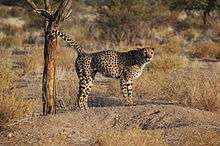
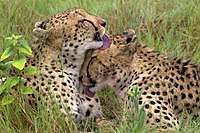
.jpg)
The cheetah is a vocal felid with a broad repertoire of calls and sounds; the acoustic features and usage of many of these have been studied in detail.[124] The vocal characteristics, such as the sounds and the way they are produced, are often different from those of other cats.[125] For instance, a study showed that exhalation of air is louder than inhalation in cheetahs, while no such distinction was observed in the domestic cat.[126][127] Listed below are some of the commonly recorded vocalisations observed in cheetahs:
- Chirping: A chirp (also referred to as a 'stutter-bark') sounds like an intense, bird-like call and lasts less than a second; it differs from sounds produced by other cats. Cheetahs chirp when they are excited, for instance when gathered around a kill. Other uses include summoning of concealed or lost cubs by the mother, as a form of greeting or courtship between adults.[125] The cheetah's chirp is similar to the soft roar of the lion, and its churr as the latter's loud roar. [124] A similar but louder call ('yelp') that can be heard from up to 2 km (1.2 mi) away; this call is typically used by mothers to locate lost cubs, or by cubs to find their mothers and siblings.[70][72]
- Churring (or churtling): A churr is a shrill, staccato call that can last up to 2 seconds. This, together with chirping, have been noted for their similarity to the soft and loud roars of the lion. This sound is produced in similar context as chirping, but a study of feeding cheetahs found chirping to be significantly more common.[78][125]
- Purring: Similar to purring in domestic cats but much louder, it is produced when the cheetah is content, and as a form of greeting or when licking one another.[70][125] It involves continuous sound production alternating between egressive and ingressive airstreams.[128][129]
- Agnostic sounds: These include bleating, coughing, growling, hissing, meowing and moaning (or yowling). A bleat indicates distress, for instance when a cheetah confronts a predator that has stolen its kill. Growls, hisses and moans are accompanied by multiple, strong hits on the ground with the front paw, during which the cheetah may retreat by a few metres.[125][124][130] A meow, though a versatile call, is typically associated with discomfort or irritation.[124][131]
- Other vocalisations: Individuals can make a gurgling noise as part of a close, amicable interaction.[70] A nyam nyam sound may be produced while eating. Apart from chirping, mothers can use a repeated ihn ihn is to gather cubs, and a prr prr is to guide them on a journey. A low-pitched alarm call is used to warn the cubs to stand still. Bickering cubs can let out a 'whirr' – the pitch rises with the intensity of the quarrel, and ends on a harsh note.[78][125]
Another major means of communication is by scent – males often investigate urine-marked places (territories or common landmarks) for a long time by crouching on their forelegs and carefully smelling the place. Then they will themselves urinate there and sniff at their own scent before leaving; other observing individuals might repeat the ritual. Females may also show marking behavior but less prominently than males do. Among females, those in oestrus will show maximum urine-marking, and their excrement can attract males from far off. Males marking their territory by urination stand close to an elevated spot (such as tree trunks, stumps or rocks) with the tail raised and the penis pointed at the area to be marked. In Botswana, cheetahs are frequently captured by ranchers who set up traps in traditional marking spots; the calls of the trapped cheetah can allure more cheetahs to the place.[78][73]
Touch and visual cues are other ways of signaling in cheetahs. Social meetings involve mutual sniffing of the oral area, anus and genitals. Individuals will groom one another, lick each other's faces and rub cheeks. However they seldom lean on or rub their flanks against each other. The tear streaks on the face can sharply define expressions at close range. The alternate light and dark rings on the tail of a mother probably serve as a signal to cubs to follow her.[78]
Diet and hunting
The cheetah is a carnivore that hunts small- to medium-sized prey weighing 20 to 60 kg (44 to 132 lb), but mostly below 40 kg (88 lb). The primary prey are medium-sized ungulates; some ungulates are the major diet in certain areas, such as Dama and Dorcas gazelles in the Sahara, impala in the eastern and southern African woodlands, springbok in the arid savannas to the south and Thomson's gazelle in the Serengeti; in India cheetahs used to prey mostly on blackbuck. Smaller antelopes such as the common duiker are a common prey in the southern Kalahari. Larger ungulates are typically avoided, though nyala, whose males weigh around 120 kg (260 lb), were found to be the major prey in a study in the Phinda Game Reserve. In Namibia cheetahs are the major predators of livestock.[70][10][132] The diet of Asiatic cheetahs consists of livestock as well as local species such as chinkara, desert hare, goitred gazelles, urial and wild goats—many of these might weigh outside the preferred range.[74][133] There are no records of cheetahs killing human beings.[74][75] Cheetahs in the Kalahari have been reported feeding on citron melons.[74] Prey preferences and success in hunting vary with the age, sex and number of cheetahs involved in the hunt and on the vigilance of the prey. Generally only groups of cheetahs (coalitions or mother and cubs) will try to kill larger prey; mothers especially look out for larger prey and tend to be more successful than females without cubs. Individuals on the periphery of the prey herd are common targets; vigilant prey that would react fast on seeing the cheetah are not preferred.[70][28][134]
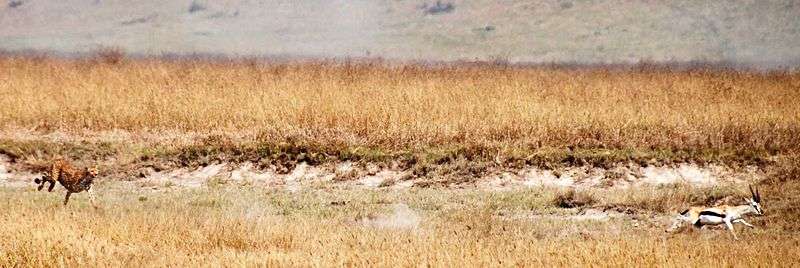
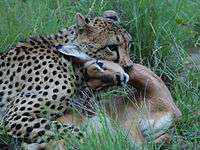
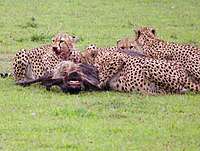
Cheetahs hunt primarily throughout the day, sometimes with peaks at dawn and dusk; they tend to avoid larger predators, such as the lion, that are primarily nocturnal.[74] Cheetahs in the Sahara and the Masai Mara hunt after sunset to escape the high temperatures of the day.[135] Cheetahs use their vision to hunt instead of their sense of smell; they keep a lookout for prey from resting sites or low branches. The cheetah will stalk its prey, trying to conceal itself in cover, and try to approach as close as possible, often within 60 to 70 m (200 to 230 ft) of the prey (or even farther for less alert prey). Alternatively the cheetah can lay hidden in cover and wait for the prey to come nearer. A stalking cheetah assumes a partially crouched posture, with the head lower than the shoulders; it will move slowly and turn still at times. In areas of minimal cover the cheetah will approach within 200 m (660 ft) of the prey and start the chase. The chase typically lasts a minute; in a 2013 study the length of chases averaged 173 m (568 ft), and the longest run measured 559 m (1,834 ft). The cheetah can give up the chase if it is detected by the prey early or if it can not make a kill quickly. Cheetahs kill their prey by tripping it during the chase by hitting its rump with the forepaw or using the strong dewclaw to knock the prey off its balance, bringing it down with much force and sometimes even breaking one of its limbs.[70][78] Cheetahs can decelerate extremely fast towards the end of the hunt, slowing down from 93 km/h (58 mph) to 23 km/h (14 mph) in just three strides, and can easily follow any twists and turns the prey makes as it tries to flee.[74] To kill medium- to large-sized prey the cheetah bites the prey's throat to suffocate it and lies down, maintaining the bite for around five minutes, within which the prey stops struggling. A bite on the nape of the neck or the snout (and sometimes on the skull) suffices to kill smaller prey.[70][78] Cheetahs have an average hunting success rate of 25–40%, higher for smaller and more vulnerable prey.[89][74]
Once the hunt is over, the prey is taken near a bush or a tree; the cheetah, highly exhausted after the chase, rests beside the kill and pants heavily for five to 55 minutes. Meanwhile cheetahs nearby, who did not take part in the hunt, might start feeding on the kill immediately. Groups of cheetah devour the kill peacefully, though minor noises and snapping may be observed.[70] Cheetahs can consume large quantities of food; a cheetah at the Etosha National Park was found to consume as much as 10 kilograms (22 lb) within two hours.[136] However on a daily basis a cheetah feeds on around 4 kg (8.8 lb) meat.[78] Cheetahs, especially mothers with cubs, remain cautious even as they eat, pausing to look around for new prey or for predators who may steal the kill.[137] Cheetahs move their heads from side to side so that the sharp carnassial teeth effectively tear the flesh, which can then be swallowed without chewing. They typically begin with the hindquarters, and then progress toward the abdomen and the spine. Rib bones are chewed on at the ends, and the limbs are not generally torn apart while eating. Unless the prey is very small, the skeleton is left almost intact after feeding on the meat. Cheetahs might lose 10−15% of their kills to large carnivores such as hyenas and lions (grey wolves in Iran). To defend itself or its prey, a cheetah will hold its body low to the ground, and produce a snarl with its mouth wide open, the eyes staring threateningly ahead and the ears folded backward. This may be accompanied by moans, hisses, and growls, and hitting the ground with the paws.[78] Cheetahs have rarely been observed to feed on the kills of other carnivores; this may be due to vultures and spotted hyena adroitly capturing and consuming heavy carcasses within a short time; male cheetahs often take kills from females.[74][70][138]
Reproduction and life cycle
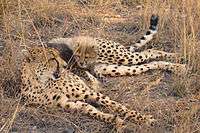
.jpg)
Cheetahs are induced ovulators, and can breed throughout the year. Females can have their first litter at two to three years of age. Polyestrous, females have an oestrus ("heat") cycle every 12 days on average, but this can vary broadly from three days to a month. A female can conceive again after 17 to 20 months of giving birth, or even sooner if a whole litter is lost; a study in the Serengeti National Park showed females who lost their litters could again conceive after around 18 days. Males can start breeding at less than two years of age in captivity, but this may be delayed in the wild until the male acquires a territory.[4][78][121][139] A 2007 study showed that females who gave birth to more litters early in their life often died younger, indicating a trade-off between longevity and yearly reproductive success.[140]
Urine-marking in males can become more pronounced when a female in their vicinity comes into oestrus. Males, sometimes even those in coalitions, fight among one another to secure access to the female.[141] Often one male will eventually win dominance over the others and mate with the female, though a female can mate with different males.[142] Mating begins with the male approaching the female, who lies down on the ground; individuals often chirp, purr or yelp at this time. No courtship behaviour is observed; the male immediately secures hold of the female's nape and copulation takes place. Cheetahs can copulate three to five times per day. The pair then ignore each other, but meet and copulate a few more times within the next two to three days before finally parting ways.[4][78][143]
After a gestational period of nearly three months, a litter of one to eight cubs is born (though those of three to four cubs are more common). Births takes place at 20–25 minute intervals in a sheltered place such as thick vegetation. A newly born cub weighs nearly 150–400 g (5.3–14.1 oz); the eyes, shut at birth, open in four to 11 days. Newborn cubs might spit a lot, and make soft churring noises; they start walking by the age of two weeks. Their nape, shoulders, and back are thickly covered with long bluish grey hair. This downy underlying fur, called a "mantle", gives them a Mohawk-type appearance; this fur is shed as the cheetah grows older.[15][78] It has been suggested that this mane gives a cheetah cub the appearance of the honey badger, and could act as camouflage from attacks by these badgers or predators that tend to avoid them.[144] In comparison to other felids, cheetah cubs are highly vulnerable to large predators such as lions during the first few weeks of their life;[145][146] Mothers keep their cubs hidden in dense vegetation for the first two months and nurse in the early morning. A mother cheetah is extremely vigilant at this stage; she stays within 1 km (0.62 mi) of the lair, frequently visits her cubs, moves them every five to six days, remains with them at night. Though she tries to make minimal noise that might give away the location of the cubs to predators, they are often detected and the mother usually can not defend her litter from these predators. Predation is the leading cause of mortality in cheetah cubs; in areas with low density of predators (such as Namibian farmlands) around 70% of the cubs make it beyond the age of 14 months, whereas in areas like the Serengeti National Park, where several large carnivores exist, the survival rate fell to just 17%. Other reasons might be starvation if their mothers abandon them, fires or pneumonia due to exposure to bad weather.[78][121] Generation length of the cheetah is six years.[147]
Cubs start coming out of the lair at two months of age, trailing after their mother wherever she goes. Now the mother spends lesser time nursing and brings solid food for the cubs; they initially retreat away from the carcass in fear, but gradually start eating it. The cubs might purr as the mother licks them clean after the meal. The mother will avoid nursing her cubs when they turn four months old. To train her cubs in hunting, the mother will catch and let go of live prey in front of her cubs.[121] Play behaviour of cubs includes chasing, crouching, pouncing and wrestling; there is plenty of agility, and attacks are seldom lethal.[78] A study of play behavior of cheetah cubs showed that cubs tend to play after nursing or while they are on the move with their mothers. Playing can improve catching skills in cubs, though the ability to crouch and hide may not develop remarkably.[121][148] Cubs as young as six months try to capture small prey like hares and juvenile gazelles. However, they may have to wait until as long as 15 months of age to make a successful kill on their own. At around 20 months, offspring become independent; mothers might have conceived again by then. Siblings might remain together a few more months before parting ways; while females stay close to their mothers, males move farther off.[78][121][149] The lifespan of wild cheetahs is 14 to 15 years for females; their reproductive cycle typically ends by 12 years of age. Males generally live as long as ten years.[1]
Habitat and distribution
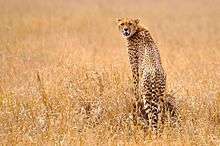
Cheetahs occur in a variety of habitats; areas with greater availability of prey, good visibility and minimal chances of encountering larger predators are preferred.[120] In a study in the Kruger National Park, female cheetahs were found to spend a significant amount of time in woodlands, where impala occurred. It was suggested that though the forested area was unsuitable for hunting, females preferred woodlands to encounter more impala. Male coalitions, on the other hand, shunned dense habitats and spent most of the time in open savannahs. An explanation for this could be that coalitions prefer larger prey than impala.[150] Compared to other felids, cheetahs appear to be less selective in habitat choice.[120] Although they do not prefer tropical forests and montane regions, cheetahs have been reported at elevations as high as 4,000 m (13,000 ft). An open area with some cover, such as diffused bushes, is probably ideal for the cheetah because it needs to stalk and pursue its prey over a distance, exploiting its speed. This also minimises the risk of encountering larger carnivores and kleptoparasitism. Complete lack of cover, however, can be a cause of prey loss and mortality.[120][15][151] Unlike other big cats in Africa, the cheetah tends to occur in low densities typically between 0.3 and 3 adults per 100 km2 (39 sq mi)—these values are 10–30% of those reported for leopards and lions. The population density can fall to 0.02–0.05 per 100 km2 (39 sq mi) in harsh habitats such as the Sahara. These numbers, however, might not give an accurate idea of populations in an area as cheetahs often do not occur uniformly in a region.[120]
Cheetahs in eastern and southern Africa occur mostly in savannas such as the Kalahari and Serengeti. In central, northern and western Africa cheetahs inhabit arid mountain ranges and valleys; in the harsh climate of Sahara cheetahs prefer high mountains, which receive more rainfall than the surrounding desert. The vegetation and water resources in these mountains supports antelopes. Iranian cheetahs occur in hilly terrain of deserts at elevation up to 2,000–3,000 m (6,600–9,800 ft), where annual precipitation is generally below 100 mm (3.9 in); the primary vegetation in these areas is thinly distributed shrubs, less than 1 m (3.3 ft) tall.[1][74][120]
Historical range
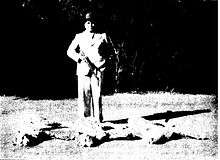
In prehistoric times, the cheetah was distributed throughout Africa, Asia, Europe and North America.[70] It gradually fell to extinction in Europe and North America, possibly due to competition with the lion.[15]:38 Today the cheetah has been extirpated in the majority of its historical range; the numbers of the Asiatic cheetah had begun plummeting since the late 1800s, long before the other subspecies started their decline. As of 2017, cheetahs occur in just 9% of their erstwhile range in Africa, mostly in unprotected areas.[27]
In the past, the cheetah ranged across vast stretches in Asia, from the Arabian Peninsula in the west to the Indian subcontinent in the east, and as far north as the Caspian and Aral Seas until mid-20th century.[152][153][154] A few centuries back the cheetah was abundant in India, and its range coincided with the distribution of major prey such as the blackbuck.[70][155] However, its numbers in India plummeted 19th century onward; Divyabhanusinh of the Bombay Natural History Society notes that the last three individuals in the wild were killed by Maharaja Ramanuj Pratap Singh of Surguja (a man also noted for holding a record for shooting 1,360 tigers) in 1947.[156][157] The last confirmed sighting in India was of a cheetah that drowned in a well near Hyderabad in 1957.[155] In Iran there were around 400 cheetahs before World War II, distributed across deserts and steppes to the east and the borderlands with Iraq to the west; the numbers were declining due to prey inavailability. In Iraq cheetahs were reported from Basra in the 1920s. Conservation efforts began in Iran in the 1950s; this was followed by an increase in cheetah sightings over the years in some areas. However, the Iranian Revolution (1979) and the Iran–Iraq War (1980–1988) led to severe depletion of prey. This led to significant contraction in the historical range of the cheetah in Iran over the following decades.[27][154]
The first survey of cheetah populations in Africa by British environmentalist Norman Myers in 1975 revealed their broad occurrence throughout Sub-Saharan Africa, especially in the eastern and southern parts of the continent. The only exception appeared to be the desert region on the western coast of modern-day Angola and Namibia. The population was estimated at around 15,000 individuals, mostly distributed in savannas and semi-arid areas south of 15°S.[151] In the following years, as their natural habitat was heavily modified, cheetah populations across the region have become smaller and more fragmented.[158][159][160] For instance, numbers in Zimbabwe have fallen drastically following civil wars and the implementation of land reforms.[161][162]
Present distribution
The cheetah occurs mostly in eastern and southern Africa; its presence in Asia is limited to the central deserts of Iran, though there have been unconfirmed reports of sightings in Afghanistan, Iraq and Pakistan in the last few decades.[1][27] The global population of cheetahs was estimated at nearly 7,100 individuals in 2016. The Iranian population appears to have decreased from 60 to 100 individuals in 2007 to merely 43 in 2016, distributed in three subpopulations over less than 150,000 km2 (58,000 sq mi) in Iran's central plateau.[163][164][165] The largest population (nearly 4,000 individuals) is sparsely distributed over Angola, Botswana, Mozambique, Namibia, South Africa and Zambia. Another population, spread in Kenya and Tanzania, comprises 1,000 individuals. All other cheetahs occur in small, fragmented groups (mostly less than 100 individuals in each) throughout the range. Populations are feared to be declining, especially those of adults.[164] The cheetah was reintroduced in Malawi in 2017.[166]
Threats
The cheetah is threatened by habitat loss and fragmentation of populations; through agricultural and industrial expansion. Moreover, the species apparently requires a large area to live in as indicated by its low population densities. Shortage of prey and conflict with other species such as humans and large carnivores are other major risks.[1][167] The cheetah appears to be less capable of coexisting with humans than the leopard.[168] With 76% of its range consisting of unprotected land, the cheetah is often targeted by farmers and pastoralists who attempt to protect their livestock, especially in Namibia.[169] Illegal wildlife trade and trafficking is another problem in some places (such as Ethiopia). Some tribes, such as the Maasai people in Tanzania, have been reported to use cheetah skins in ceremonies.[39][20] Roadkill is another threat, especially in areas where roads have been constructed near natural habitat or protected areas. Cases of roadkill involving cheetahs have been reported from Kalmand, Touran National Park, and Bafq in Iran. The threat posed by infectious diseases may be minor, given the low population densities and hence the reduced chance of infection.[1]
Conservation measures
The cheetah has been classified as Vulnerable by the IUCN; it is listed under Appendix I of the Convention on the Conservation of Migratory Species of Wild Animals (CMS) and Appendix I of CITES (Convention on International Trade in Endangered Species). The IUCN has recommended co-operation between countries across the cheetah's range to minimize the conflict between cheetahs and human beings.[1] A 2016 study showed that ecotourism can have a significantly positive impact on the conservation of the cheetah. Although the requirement of space for the habitat would have to be compromised in most cases, establishment of private reserves for cheetahs and ensuring the absence of predators and poachers could be a successful conservation measure.[170] Additionally, the financial benefits accrued and the awareness generated can further aid the cause of the cheetah.[1] "Ambassador" cheetahs have been displayed in public as part of an educational initiative to create awareness about cheetahs and their conservation.[171][172]
In Africa
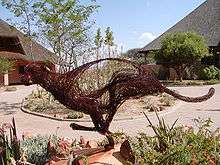
Until the 1970s, cheetahs among other carnivores were frequently killed to protect livestock in Africa. In 1968, George Schaller published the first study of cheetahs in the wild, followed by Myers' survey in 1975; gradually the understanding of their ecology increased and their falling numbers became a matter of concern.[20] In 1984 the North American Cheetah Species Survival Plan (SSP) had been developed by the American Association of Zoos and Aquariums (AZA) to integrate efforts for cheetah conservation, and by 1987 to outline the first major research project was underway. [173] The De Wildt Cheetah and Wildlife Centre was set up in 1971 in South Africa to provide care for wild cheetahs regularly trapped and killed by Namibian farmers. The Cheetah Conservation Fund, founded by Laurie Marker in 1990 in Namibia, put efforts into field research and education about cheetahs on the global platform.[20] It also runs a cheetah genetics laboratory, the only one of its kind, in Otjiwarongo (Namibia).[174] Several more cheetah-specific cheetah conservation programs have since come into existence, such as Cheetah Conservation Botswana (CCB), Cheetah Outreach (South Africa) and Action for Cheetahs in Kenya (ACK).[20]
The Cheetah Species Survival Program (SSP), developed by the Association of Zoos and Aquariums (AZA), partnered with the IUCN Conservation Breeding Specialist Group (CBSG) and the CCF conduct the first Global Cheetah Action Plan Workshop in 2001; by 2002 emphasis was placed on the need for a rangewide survey of wild cheetahs to demarcate areas for conservation efforts, and on creating awareness through training programs.[175] In 2007, the Range Wide Conservation Program for Cheetah and African Wild Dogs (RWCP), the brainchild of Sarah Durant and Rosie Woodroffe (of the Zoological Society of London), was started with the primary aim of ensuring better conservation measures for the cheetah and the African wild dog – two species with very low population densities in Africa. Funded by The Howard G. Buffett Foundation, the program is a joint initiative of the IUCN Cat and Canid Specialist Groups, the Wildlife Conservation Society and the Zoological Society of London. Its major goals include a review of the conservation policies adopted by African countries, and assessment and action regarding illegal hunting and trade. National conservation plans have been successfully developed for several African countries;[176][177]
A year after the first survey of cheetahs in Algeria, the Observatoire du Guépard en Régions d'Afrique du Nord (North African Region Cheetah Organization) met in Tamanrasset in 2006 to discuss conservation strategies for cheetahs in the country. Data collection and census methods were stressed upon, and fieldwork began in the Ahaggar National Park; in 2015 the first camera trap evidence of cheetahs in the region was obtained.[178] In 2014 the CITES Standing Committee recognised the cheetah as a "species of priority" in their strategies in northeastern Africa to counter wildlife trafficking.[179] In 2015, the southern African cheetah conservation plans and distribution maps were revised by the RWCP.[20] In December 2016 the results of an extensive survey detailing the distribution and demography of cheetahs throughout the range were published; the researchers recommended listing the cheetah as Endangered on the IUCN Red List.[164]
In Asia

In 2001 the Iranian government collaborated with the Cheetah Conservation Fund, the IUCN, Panthera Corporation, United Nations Development Programme (UNDP), and the Wildlife Conservation Society on the Conservation of Asiatic Cheetah Project (CACP) to protect the natural habitat of the Asiatic cheetah and its prey, to ensure that development projects do not hamper its survival, and to highlight the plight of the Asiatic cheetah.[180][181] In 2004 the Iranian Centre for Sustainable Development (CENESTA) conducted the International Workshop on the Conservation of Asiatic Cheetah to discuss conservation plans with local stakeholders.[20] Iran declared 31 August as National Cheetah Day in 2006.[182] The Iranian Cheetah Strategic Planning meet in 2010 formulated a five-year conservation plan for the Iranian cheetahs.[20] The CACP Phase II was implemented in 2009, and the third phase was drafted in 2018.[183]
During the early 2000s, scientists from the Centre for Cellular and Molecular Biology (CCMB), Hyderabad, proposed a plan to clone Asiatic cheetahs obtained from Iran. India asked Iran to transport one live pair to India, or, if that was not possible, allow them to collect sperm and eggs of the cheetah pair in Iran itself.[184] However, Iran rejected both proposals.[185] In September 2009, the then Minister of Environment and Forests, Jairam Ramesh, assigned the Wildlife Trust of India and the Wildlife Institute of India with the task of examining the potential of importing cheetahs from Africa for a possible reintroduction in India.[186] The report, submitted in 2010, showed that the Kuno Wildlife Sanctuary and Nauradehi Wildlife Sanctuary in Madhya Pradesh and Shahgarh Landscape in Rajasthan have a high potential to support reintroduced cheetah populations due to their broad area and high prey density.[187][188] However, plans for reintroduction were stalled in May 2012 by the Supreme Court of India due to political dispute and concerns over introducing a completely new species to the country, stating it was "not case of intentional movement of an organism into a part of its native range".[189][190][191] On 28 January 2020, the Supreme Court allowed the central government to introduce cheetahs to a suitable habitat in India on an experimental basis to see if they can adapt.[192][193][194]
Interaction with human beings
Taming
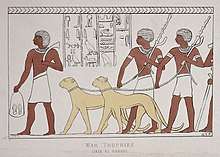
The cheetah shows little aggression toward human beings, and can be easily tamed, as it has been since antiquity.[15] The earliest known depictions of the cheetah are from the Chauvet Cave in France, dating back to 32,000–26,000 BC.[195] Two primary theories have been put forth to explain the expansion of the domesticated cheetah.[196][197] Historians who accept the Sumerian origin of the domesticated cheetah – such as Heinz F. Friederichs and Burchard Brentjes – hold that the animal gradually spread out to central and northern Africa, from where it reached India. On the other hand, historians such as Frederick E. Zeuner accept the Egyptian origin and state that the cheetah gradually spread into central Asia, Iran, and India.[196] A Sumerian seal dating back to c. 3000 BC, featuring a long-legged leashed animal with an elongated snout and an erect tail that has often been claimed to be a cheetah, has fuelled speculation that the cheetah might have been first domesticated and used for hunting in Sumer (Mesopotamia).[81][198][199] However, Thomas T. Allsen argues that the depicted animal might be a large dog instead of a cheetah; moreover, the background gives an impression of a montane area, which the cheetah does not typically inhabit.[197]
In comparison, the theory of Egyptian origin has held stronger and possible timelines for the cheetah's domestication have been proposed on its basis.[196] Mafdet, one of the ancient Egyptian deities worshiped during the First Dynasty (c. 3100 BC – c. 2900 BC), was sometimes depicted as a cheetah. Ancient Egyptians believed that the spirits of deceased pharaohs were taken away by cheetahs.[195] Reliefs in the Deir el-Bahari temple complex tell of an expedition by Egyptians to the Land of Punt during the reign of the pharaoh Hatshepsut (1507–1458 BC) that fetched, among other things, animals called "panthers" for Egypt. Two types of "panthers" were depicted in these sculptures: leashed cheetahs, referred to as "panthers of the north", and sturdy leopards, referred to as "panthers of the south". During the New Kingdom (16th to 11th centuries BC), cheetahs were common pet animals for the royalty, who adorned the animals with ornate collars and leashes.[196] The Egyptians would use their dogs to bring the concealed prey out in the open, after which a cheetah would be set upon it to kill it.[200] Rock carvings depicting cheetahs have been found in Twyfelfontein dating back to 2000–6000 years ago; little else has been discovered in connection to the taming of cheetahs (or of other cats) in southern Africa.[195]
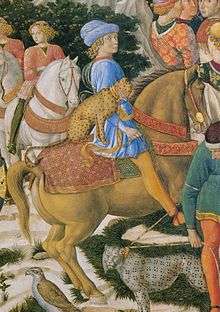
Hunting cheetahs are known in pre-Islamic Arabic art from Yemen.[201] Hunting with cheetahs became more prevalent toward the seventh century AD. In the Middle East, the cheetah would accompany the nobility to hunts in special seats behind saddles. Cheetahs continued to be associated with royalty and elegance in western Asia until as late as the 19th century. The first phase of taming would take several weeks, in which the cheetah would be kept tethered and made to get accustomed to human beings. Next, the cheetah would be tempted with food and trained to mount horses. Finally, its hunting instincts would be aroused by slaughtering animals before it. The whole process could take as long as a year to complete. The cheetah gradually entered Eurasia toward the 14th century, though they never became as popular as they had in the Middle East.[196] In the third century AD, Roman author Claudius Aelianus wrote of tame panthers in India and "smaller lions" that would be used for tracking and hunting; the account may not be reliable as Roman, as well as Greek, literature is generally unclear in its references to different types of cats.[202] The Romans may have referred to the cheetah as the leopardos (λεοπάρδος) or leontopardos (λεοντόπαρδος), believing it to be the result of hybridisation between a leopard and a lion due to the manes they possess as cubs and the difficulty of breeding them in captivity.[203] A Roman hunting cheetah is depicted in the 4th century mosaic from Lod, Israel.[204] They continued to be used into the Byzantine period of the Roman empire, with "hunting leopards" being mentioned in the Cynegetica of Koukoules.[203][205] The 11th-century Clephane Horn, possibly of Byzantine origin, is believed to depict domesticated hunting cheetahs.[206]

In eastern Asia, the records are confusing as regional names for the leopard and the cheetah may be used interchangeably. The earliest depiction of cheetahs from eastern Asia dates back to the Tang dynasty (7th to 10th centuries AD); paintings depict tethered cheetahs as well as cheetahs mounted on horses. Chinese emperors would use cheetahs, as well as caracals, as gifts. In the 13th and the 14th centuries, the Yuan rulers bought numerous caracals, cheetahs, and tigers from the western parts of the empire and Muslim merchants, in return for gold, silver, cash, and silk. According to the Ming Shilu, the subsequent Ming dynasty (14th to 17th centuries) continued this practice.[196] Tomb figurines from the Mongol empire, dating back to the reign of Kublai Khan (1260–1294 BC), represent caracals and cheetahs on horseback.[195] The Mughal ruler Akbar the Great (1556–1605 AD) is said to have kept as many as 1000 khasa (imperial) cheetahs.[89][195] However, his son Jahangir wrote in his memoirs, Tuzk-e-Jahangiri, that only one of them gave birth to cubs.[196] Mughal rulers trained cheetahs as well as caracals in a similar way as the West Asians, and used them to hunt game – especially blackbuck. The rampant hunting severely affected the populations of wild animals in India;[207][208] by 1927, cheetahs had to be imported from Africa.[195]
In captivity
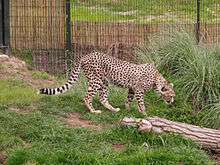
The earliest record of a cheetah litter born in captivity dates back to the reign of Akbar the Great (16th century). The cheetah to be brought into captivity in a zoo was at the Zoological Society of London in 1829; more individuals began to be held 1851 onward in many other European zoos, and in 1871 a cheetah was exhibited at the Central Park Zoo (New York). The early captive cheetahs showed a high mortality rate, with an average lifespan of 3–4 years. From 1955 to 2014, more than 2000 cheetahs have been taken into zoological institutions; initially wild cheetahs were captured from eastern Africa (mainly Kenya and Somalia), but as numbers plummeted in these areas Namibia and South Africa (particularly the De Wildt Cheetah and Wildlife Centre) led in cheetah exports from the late 1960s. After trade of wild cheetahs was delimited by the enforcement of CITES in 1975, more efforts were put into breeding in captivity; in 2014 the number of captive cheetahs worldwide was estimated at around 1730 individuals, with 87% born in captivity.[20][209]
Mortality under captivity is generally high; in 2014, 23% of the captive cheetahs worldwide died under 1 year of age, mostly within a month of birth.[209] Deaths result from several reasons—stillbirths, birth defects, cannibalism, hypothermia, neglect of cubs by mothers, and infectious diseases.[210] Compared to other felids, cheetahs need specialized care due to their higher vulnerability to stress-induced diseases. High density of cheetahs in a place, closeness to other large carnivores in enclosures, improper handling, exposure to public and frequent movement between zoos can be sources of stress for cheetahs. This elevated susceptibility to disease, especially contagious ones, has often been attributed to the low genetic variability in cheetahs; studies in the 1990s, however, showed that morbidity and mortality are mostly due to degenerative diseases instead, and are often linked to factors of captive life.[211] Captive cheetahs typically have higher corticosteroid levels than their wild counterparts, which can have a negative impact on physiological processes such as immune response.[212] Gastroenteritis, that was detected in 91% of the captive population in several North American zoos during 1989–1992, has been studied well in cheetahs and is associated with elevated stress levels. Other common diseases recorded in cheetahs include feline herpesvirus, feline infectious peritonitis, glomerulosclerosis, leukoencephalopathy, myelopathy, nephrosclerosis and veno-occlusive disease.[211][213][214][215] Recommended management practices for cheetahs include spacious and ample access to outdoors, stress minimisation by exercise and limited handling, and following proper hand-rearing protocols (especially for pregnant females).[216][217][218]
Cheetahs are poor breeders in captivity, while wild individuals are far more successful;[219] this has also been linked to increased stress levels in captive individuals.[211] In a 1992 study, females in Serengeti were found to have 95% success rate in breeding.[139] In contrast, only 20% of the North American captive cheetahs bred successfully in 1991.[220][221] On 26 November 2017, a female cheetah named Bingwa gave birth to eight cubs in the Saint Louis Zoo setting a record for the most captive births for an African cheetah.[222][223] One strategy for helping captive cheetahs breed is to pair them with a companion dog.[224] Janet Rose-Hinostroza, an animal training supervisor at the San Diego Zoo Safari Park, told National Geographic in 2015 that "a dominant dog is very helpful because cheetahs are quite shy instinctively, and you can't breed that out of them. When you pair them, the cheetah looks to the dog for cues and learns to model their behavior. It's about getting them to read that calm, happy-go-lucky vibe from the dog."[225]
In culture


The cheetah has been widely portrayed in a variety of artistic works. In Bacchus and Ariadne, an oil painting by the 16th-century Italian painter Titian, the chariot of the Greek god Dionysus (Bacchus) is depicted as being drawn by two cheetahs. The cheetahs in the painting were previously considered to be leopards.[226] In 1764 English painter George Stubbs commemorated the gifting of a cheetah to George III by the English Governor of Madras, Sir George Pigot in his painting Cheetah with Two Indian Attendants and a Stag. The painting depicts a cheetah, hooded and collared by two Indian servants, along with a stag it was supposed to prey upon.[227][228] The 1896 painting The Caress, by the 19th-century Belgian symbolist painter Fernand Khnopff, is a representation of the myth of Oedipus and the Sphinx. It portrays a creature with a woman's head and a cheetah's body (often misidentified as a leopard's).[229]
The Bill Thomas Cheetah American sports/racing car, a Chevrolet-based coupe first designed and driven in 1963, was an attempt to challenge Carroll Shelby's Shelby Cobra in American sports car competition of the 1960s era. Due to only two dozen or fewer chassis ever being built, with only a dozen of these being complete cars, the Cheetah was never homologated for competition beyond prototype status, with its production ending in 1966.[230]
A variety of literature mentions the cheetah. In 1969 author Joy Adamson, of Born Free fame, wrote The Spotted Sphinx, a biography of her pet cheetah Pippa.[231] Hussein, An Entertainment, a novel by Patrick O'Brian set in the British Raj period in India, illustrates the practice of royalty keeping and training cheetahs to hunt antelopes.[232] The book How It Was with Dooms tells the true story of a family raising an orphaned cheetah cub named Dooms in Kenya. The 2005 film Duma was loosely based on this book.[233][234]
The cheetah has often been featured in marketing and animation. In 1986 Frito-Lay introduced the Chester Cheetah, an anthropomorphic cheetah, as the mascot for their Cheetos.[235][236] The first release of Apple Inc.'s Mac OS X, the Mac OS X 10.0, was code-named "Cheetah"; the subsequent versions released before 2013 were all named after cats.[237] The animated series ThunderCats had a character named "Cheetara", an anthropomorphic cheetah, voiced by Lynne Lipton.[238] Comic book superheroine Wonder Woman's chief adversary is Dr. Barbara Ann Minerva, alias The Cheetah.[239]
Two cheetahs are depicted standing upright and supporting a crown in the coat of arms of Free State (South Africa).[240]
See also
- List of largest cats
References
- Durant, S.; Mitchell, N.; Ipavec, A.; Groom, R. (2015). "Acinonyx jubatus". IUCN Red List of Threatened Species. 2015: e.T219A50649567. doi:10.2305/IUCN.UK.2015-4.RLTS.T219A50649567.en.
- "Cheetah (Acinonyx jubatus)". Environmental Conservation Online System (ECOS). US Fish and Wildlife Service. Retrieved 24 April 2020.
- Kitchener, A. C.; Breitenmoser-Würsten, C.; Eizirik, E.; Gentry, A.; Werdelin, L.; Wilting, A.; Yamaguchi, N.; Abramov, A. V.; Christiansen, P.; Driscoll, C.; Duckworth, J. W.; Johnson, W.; Luo, S.-J.; Meijaard, E.; O’Donoghue, P.; Sanderson, J.; Seymour, K.; Bruford, M.; Groves, C.; Hoffmann, M.; Nowell, K.; Timmons, Z. & Tobe, S. (2017). "A revised taxonomy of the Felidae: the final report of the Cat Classification Task Force of the IUCN Cat Specialist Group" (PDF). Cat News (Special Issue 11): 30–31.
- Krausman, P. R. & Morales, S. M. (2005). "Acinonyx jubatus" (PDF). Mammalian Species. 771: 1–6. doi:10.1644/1545-1410(2005)771[0001:aj]2.0.co;2. Archived from the original (PDF) on 4 March 2016.
- Platts, J. T. (1884). "चीता ćītā". A Dictionary of Urdu, Classical Hindi, and English. London: W. H. Allen & Co. p. 470.
- Macdonell, A. A. (1929). "चित्रय kitra-ya". A Practical Sanskrit Dictionary with Transliteration, Accentuation, and Etymological Analysis throughout. London: Oxford University Press. p. 68.
- "Cheetah". Merriam-Webster Dictionary. Retrieved 24 December 2019.
- Liddell, H. G. & Scott, R. (1889). An Intermediate Greek–English Lexicon. Oxford: Clarendon Press. pp. 27, 560.
- Rosevear, D. R. (1974). "Genus Acinonyx Brookes, 1828". The Carnivores of West Africa. London: Natural History Museum. pp. 492–512. ISBN 978-0-565-00723-2.
- Skinner, J. D. & Chimimba, C. T. (2005). "Subfamily Acinonychinae Pocock 1917". The Mammals of the Southern African Subregion (3rd ed.). New York: Cambridge University Press. pp. 379–384. ISBN 978-0521844185.
- Meachen, J.; Schmidt-Kuntzel, A.; Haefele, H.; Steenkamp, G.; Robinson, J. M.; Randau, M. A.; McGowan, N.; Scantlebury, D. M.; Marks, N.; Maule, A. & Marker, L. (2018). "Cheetah specialization: physiology and morphology". In Marker, L.; Boast, L. K. & Schmidt-Kuentzel, A. (eds.). Cheetahs: Biology and Conservation. London: Academic Press. pp. 93–106. ISBN 978-0-12-804088-1.
- Lewis, C. T. & Short, C. (1879). A Latin Dictionary. Oxford: Clarendon Press. p. 1014.
- Schreber, J. C. D. (1777). "Der gepard (The cheetah)". Die Säugthiere in Abbildungen nach der Natur mit Beschreibungen (dritter theil) [The Mammals in Illustrations according to Nature with Descriptions (third part)] (in German). Erlangen: Wolfgang Walther. pp. 392–393.
- Brookes, J. (1828). "Section Carnivora". A Catalogue of the Anatomical and Zoological Museum of Joshua Brookes. London: Richard Taylor. p. 16.
- Caro, T. M. (1994). "Serengeti, and the taxonomy and natural history of cheetahs". Cheetahs of the Serengeti Plains: Group Living in an Asocial Species. Chicago: University of Chicago Press. pp. 15–48. ISBN 978-0-226-09434-2.
- Sclater, P. (1877). "The secretary on additions to the menagerie". Proceedings of the Zoological Society of London: 530–533.
- Lydekker, R. (1893). "The hunting leopard". The Royal Natural History. 1. London: Frederick Warne & Co. pp. 442–446.
- Griffith, E. (1821). "Felis venatica". General and Particular Descriptions of the Vertebrated Animals, arranged Conformably to the Modern Discoveries and Improvements in Zoology. Order Carnivora. London: Baldwin, Cradock and Joy. p. 93.
- Partington, C. F. (1835). The British Cyclopaedia of Natural History. 1. London: Orr & Smith. p. 736.
- Marker, L.; Grisham, J. & Brewer, B. (2018). "A brief history of cheetah conservation". In Marker, L.; Boast, L. K. & Schmidt-Kuentzel, A. (eds.). Cheetahs: Biology and Conservation. London: Academic Press. pp. 3–16. ISBN 978-0-12-804088-1.
- Baker, E. D. (1887). Sport in Bengal: and How, When and Where to Seek it. London: Ledger, Smith & Co. pp. 205–221.
- Sterndale, R. A. (1884). Natural History of the Mammalia of India and Ceylon. Calcutta: Thacker, Spink & Co. pp. 175–178.
- Charruau, P.; Fernandes, C.; Orozco-terwengel, P.; Peters, J.; Hunter, L.; Ziaie, H.; Jourabchian, A.; Jowkar, H.; Schaller, G.; Ostrowski, S.; Vercammen, P.; Grange, T.; Schlotterer, C.; Kotze, A.; Geigl, E. M.; Walzer, C. & Burger, P. A. (2011). "Phylogeography, genetic structure and population divergence time of cheetahs in Africa and Asia: evidence for long-term geographic isolates". Molecular Ecology. 20 (4): 706–724. doi:10.1111/j.1365-294X.2010.04986.x. PMC 3531615. PMID 21214655.
- Wozencraft, W.C. (2005). "Acinonyx jubatus". In Wilson, D.E.; Reeder, D.M (eds.). Mammal Species of the World: A Taxonomic and Geographic Reference (3rd ed.). Johns Hopkins University Press. pp. 532–533. ISBN 978-0-8018-8221-0. OCLC 62265494.
- Heller, E. "New races of carnivores and baboons from equatorial Africa and Abyssinia". Smithsonian Miscellaneous Collections. 61 (19): 1–12.
- Nzangaya, A. (24 May 2017). "Cheetahs reintroduced in Malawi". Malawi24. Retrieved 8 January 2018.
- Marker, L.; Cristescu, B.; Morrison, T.; Flyman, M. V.; Horgan, J.; Sogbohossou, E. A.; Bissett, C.; van der Merwe, V.; Machado, I. B. de M.; Fabiano, E.; van der Meer, E.; Aschenborn, O.; Melzheimer, J.; Young-Overton, K.; Farhadinia, M. S.; Wykstra, M.; Chege, M.; Abdoulkarim, S.; Amir, O. G.; Mohanun, A. S.; Paulos, O. D.; Nhabonga, A. R.; M'soka, J. L. J.; Belbachir, F.; Ashenafi, Z. T. & Nghikembua, M. T. (2018). "Cheetah rangewide status and distribution". In Marker, L.; Boast, L. K. & Schmidt-Kuentzel, A. (eds.). Cheetahs: Biology and Conservation. London: Academic Press. pp. 33–54. ISBN 978-0-12-804088-1.
- Heptner, V. G. & Sludskii, A. A. (1992). "Genus of cheetah, or Pardus". Mammals of the Soviet Union. Volume II, Part 2. Carnivora (Hyaenas and Cats). Washington D.C.: Smithsonian Institution and the National Science Foundation. pp. 696–733.
- Farhadinia, M. (2004). "The last stronghold: cheetah in Iran" (PDF). Cat News. 40: 11–14.
- Khalatbari, L.; Jowkar, H.; Yusefi, G. H.; Brito, J. C. & Ostrowski, S. (2017). "The current status of Asiatic cheetah in Iran". Cat News. 66: 10–13 – via Researchgate.
- Durant, S.; Marker, L.; Purchase, N.; Belbachir, F.; Hunter, L.; Packer, C.; Breitenmoser-Würsten, C.; Sogbohossou, E.; Bauer, H. (2008). "Acinonyx jubatus ssp. venaticus". IUCN Red List of Threatened Species. 2008: e.T220A13035342. doi:10.2305/IUCN.UK.2008.RLTS.T220A13035342.en.
- Fitzinger, L. (1855). "Bericht an die kaiserliche Akademie der Wissenchaften über die von dem Herrn Consultatsverweser Dr. Theodor v. Heuglin für die kaiserliche Menagerie zu Schönbrunn mitgebrachten lebenden Thiere (Report to the Imperial Academy of Sciences about the Consultant Administrator Dr. Theodor v. Heuglin for the Living Animals brought to the Imperial Menagerie at Schönbrunn)". Sitzungsberichte der Kaiserlichen Akademie der Wissenschaften. Mathematisch-Naturwissenschaftliche Classe [Meeting Reports from the Imperial Academy of Sciences. Mathematical and Natural Science Class] (in German). pp. 242–253.
- McKeown, S. (2006). "Captive breeding of North African cheetah, Acinonyx jubatus soemmeringii" (PDF). Wildlife Middle East. 1 (2): 5.
- Durant, S.; Marker, L.; Purchase, N.; Belbachir, F.; Hunter, L.; Packer, C.; Breitenmoser-Würsten, C.; Sogbohossou, E.; Bauer, H. (2008). "Acinonyx jubatus ssp. hecki". IUCN Red List of Threatened Species. 2008: e.T221A13035738. doi:10.2305/IUCN.UK.2008.RLTS.T221A13035738.en.
- Hilzheimer, M. (1913). "Über neue Gepparden nebst Bemerkungen über die Nomenklatur dieser Tiere (About new cheetahs and comments about the nomenclature of these animals)". Sitzungsberichte der Gesellschaft Naturforschender Freunde zu Berlin [Meeting Reports of the Society of Friends of Natural Science in Berlin] (in German). pp. 283–292.
- Busby, G. B. J.; Gottelli, D.; Durant, S.; Wacher, T.; Marker, L.; Belbachir, F.; de Smet, K.; Belbachir-Bazi, A.; Fellous, A. & Belghoul, M. (2006). Parc National de L'Ahaggar survey, Algeria (March 2005), Part 5: Using molecular genetics to study the presence of endangered carnivores (PDF) (Report). Sahelo-Saharan Interest Group.
- Hamdine, W.; Meftah, T. & Sehki, A. (2003). "Distribution and status of cheetahs (Acinonyx jubatus) in the Algerian Central Sahara (Ahaggar and Tassili)". Mammalia. 67 (3): 439–443. doi:10.1515/mamm.2003.67.3.439.
- Werdelin, L.; Yamaguchi, N.; Johnson, W. E. & O'Brien, S. J. (2010). "Phylogeny and evolution of cats (Felidae)". In Macdonald, D. W. & Loveridge, A. J. (eds.). Biology and Conservation of Wild Felids. Oxford, UK: Oxford University Press. pp. 59–82. ISBN 978-0-19-923445-5.
- Van Valkenburgh, B.; Pang, B.; Cherin, M. & Rook, L. (2018). "The cheetah: evolutionary history and paleoecology". In Marker, L.; Boast, L. K. & Schmidt-Kuentzel, A. (eds.). Cheetahs: Biology and Conservation. London: Academic Press. ISBN 978-0-12-804088-1.
- Hemmer, H.; Kahlke, R.-D. & Keller, T. (2008). "Cheetahs in the Middle Pleistocene of Europe: Acinonyx pardinensis (sensu lato) intermedius (Thenius, 1954) from the Mosbach Sands (Wiesbaden, Hesse, Germany)". Neues Jahrbuch für Geologie und Paläontologie - Abhandlungen. 249 (3): 345–356. doi:10.1127/0077-7749/2008/0249-0345.
- Cherin, M.; Iurino, D. A.; Sardella, R. & Rook, L. (2014). "Acinonyx pardinensis (Carnivora, Felidae) from the Early Pleistocene of Pantalla (Italy): predatory behavior and ecological role of the giant Plio–Pleistocene cheetah". Quaternary Science Reviews. 87: 82–97. Bibcode:2014QSRv...87...82C. doi:10.1016/j.quascirev.2014.01.004.
- Geraads, D. (1997). "Carnivores du Pliocène terminalde Ahl al Oughlam (Casablanca, Maroc)" [Terminal Pliocene carnivores of Ahl al Oughlam (Casablanca, Morocco)]. Geobios (in French). 30 (1): 127–164. doi:10.1016/S0016-6995(97)80263-X.
- Mazák, J. H. (2012). "Retraction for Christiansen and Mazak, A primitive Late Pliocene cheetah, and evolution of the cheetah lineage". Proceedings of the National Academy of Sciences. 109 (37): 15072. doi:10.1073/pnas.1211510109. PMC 3443189. PMID 22908293.
- Adams, D. B. (1979). "The cheetah: native American" (PDF). Science. 205 (4411): 1155–1158. Bibcode:1979Sci...205.1155A. doi:10.1126/science.205.4411.1155. PMID 17735054.
- Van Valkenburgh, B.; Grady, F. & Kurtén, B. (1990). "The Plio-Pleistocene cheetah-like Miracinonyx inexpectatus of North America". Journal of Vertebrate Paleontology. 10 (4): 434–454. doi:10.1080/02724634.1990.10011827.
- Martin, L. D. (1998). "Felidae". In Janis, C. M.; Scott, K. M. & Jacobs, L. L. (eds.). Evolution of Tertiary Mammals of North America (1st ed.). Cambridge: Cambridge University Press. pp. 236–242. ISBN 978-0-521-35519-3.
- Barnett, R.; Barnes, I.; Phillips, M. J.; Martin, L. D.; Harington, C. R.; Leonard, J. A. & Cooper, A. (2005). "Evolution of the extinct sabretooths and the American cheetah-like cat". Current Biology. 15 (15): R589–R590. doi:10.1016/j.cub.2005.07.052. PMID 16085477.
- Johnson, W. E. & O'Brien, S. J. (1997). "Phylogenetic reconstruction of the Felidae using 16S rRNA and NADH-5 mitochondrial genes". Journal of Molecular Evolution. 44 (S1): S98–S116. Bibcode:1997JMolE..44S..98J. doi:10.1007/PL00000060. PMID 9071018.
- Johnson, W. E. (2006). "The Late Miocene radiation of modern Felidae: a genetic assessment". Science. 311 (5757): 73–77. doi:10.1126/science.1122277. PMID 16400146.
- Dobrynin, P.; Liu, S.; Tamazian, G.; Xiong, Z.; Yurchenko, A. A.; Krasheninnikova, K.; Kliver, S. & Schmidt-Küntzel, A. (2015). "Genomic legacy of the African cheetah, Acinonyx jubatus". Genome Biology. 16: 277. doi:10.1186/s13059-015-0837-4. PMC 4676127. PMID 26653294.
- O’Brien, S. J. & Johnson, W. E. (2007). "The evolution of cats" (PDF). Scientific American. 297 (1): 68–75. doi:10.1038/scientificamerican0707-68.
- Faurby, S.; Werdelin, L. & Svenning, J. C. (2016). "The difference between trivial and scientific names: there were never any true cheetahs in North America". Genome Biology. 17 (1): 89. doi:10.1186/s13059-016-0943-y. PMC 4858926. PMID 27150269.
- O'Brien, S. J.; Wildt, D. E.; Bush, M.; Caro, T. M.; FitzGibbon, C.; Aggundey, I. & Leakey, R. E. (1987). "East African cheetahs: evidence for two population bottlenecks?". PNAS. 84 (2): 508–511. Bibcode:1987PNAS...84..508O. doi:10.1073/pnas.84.2.508. PMC 304238. PMID 3467370.
- Menotti-Raymond, M. & O'Brien, S. J. (1993). "Dating the genetic bottleneck of the African cheetah". PNAS. 90 (8): 3172–3176. Bibcode:1993PNAS...90.3172M. doi:10.1073/pnas.90.8.3172. PMC 46261. PMID 8475057.
- Culver, M.; Driscoll, C.; Eizirik, E. & Spong, G. (2010). "Genetic applications in wild felids". In Macdonald, D. W. & Loveridge, A. J. (eds.). Biology and Conservation of Wild Felids. Oxford, UK: Oxford University Press. pp. 107–123. ISBN 978-0-19-923445-5.
- O'Brien, S. J.; Roelke, M.; Marker, L.; Newman, A.; Winkler, C.; Meltzer, D.; Colly, L.; Evermann, J.; Bush, M. & Wildt, D. E. (1985). "Genetic basis for species vulnerability in the cheetah". Science. 227 (4693): 1428–1434. Bibcode:1985Sci...227.1428O. doi:10.1126/science.2983425. PMID 2983425.
- O’Brien, S. J; Johnson, W. E; Driscoll, C. A; Dobrynin, P. & Marker, L. (2017). "Conservation genetics of the cheetah: lessons learned and new opportunities". Journal of Heredity. 108 (6): 671–677. doi:10.1093/jhered/esx047. PMC 5892392. PMID 28821181.
- Heeney, J. L.; Evermann, J. F.; McKeirnan, A. J.; Marker-Kraus, L.; Roelke, M. E.; Bush, M.; Wildt, D. E.; Meltzer, D. G.; Colly, L. & Lukas, J. (1990). "Prevalence and implications of feline coronavirus infections of captive and free-ranging cheetahs (Acinonyx jubatus)". Journal of Virology. 64 (5): 1964–1972. PMC 249350. PMID 2157864.
- Yuhki, N. & O'Brien, S. J. (1990). "DNA variation of the mammalian major histocompatibility complex reflects genomic diversity and population history". PNAS. 87 (2): 836–840. Bibcode:1990PNAS...87..836Y. doi:10.1073/pnas.87.2.836. PMC 53361. PMID 1967831.
- O'Brien, S. J. (2003). Tears of the Cheetah: the Genetic Secrets of our Animal Ancestors. New York: Thomas Dunne Books. pp. 15–34. ISBN 978-0-312-33900-5.
- Gugliotta, G. (2008). "Rare breed: Can Laurie Marker help the world's fastest mammal outrun its fate?". Smithsonian Magazine: 1–4.
- Thompson, S. E. (1998). "Cheetahs in a bottleneck". Built for Speed: The Extraordinary, Enigmatic Cheetah. Minneapolis: Lerner Publications Co. pp. 61–75. ISBN 978-0-8225-2854-8.
- Heuvelmans, B. (1995). "Mngwa, the strange one". On the Track of Unknown Animals (3rd, revised ed.). Abingdon: Routledge. pp. 495–502. ISBN 978-1-315-82885-5.
- Pocock, R. I. (1927). "Description of a new species of cheetah (Acinonyx)". Proceedings of the Zoological Society of London. 97 (1): 245–252. doi:10.1111/j.1096-3642.1927.tb02258.x.
- "Cheetah - guépard - duma - Acinonyx jubatus". IUCN/SSC Cat Specialist Group. Retrieved 6 May 2014.
- Shuker, K. P. N. (1989). Mystery Cats of the World: From Blue Tigers to Exmoor Beasts. London: Hale. p. 119. ISBN 978-0-7090-3706-4.
- Bottriell, L. G. (1987). "On the edge of everywhere and nowhere". King Cheetah: The Story of the Quest. Leiden: Brill. pp. 83–96. ISBN 978-90-04-08588-6.
- Aarde, R. J. van & Dyk, A. van (1986). "Inheritance of the king coat colour pattern in cheetahs Acinonyx jubatus". Journal of Zoology. 209 (4): 573–578. doi:10.1111/j.1469-7998.1986.tb03612.x.
- Kaelin, C. B.; Xu, X.; Hong, L. Z.; David, V. A.; McGowan, K. A.; Schmidt-Küntzel, A.; Roelke, M. E.; Pino, J.; Pontius, J.; Cooper, G. M.; Manuel, H.; Swanson, W. F.; Marker, L.; Harper, C. K.; Van Dyk, A.; Yue, B.; Mullikin, J. C.; Warren, W. C.; Eizirik, E.; Kos, L.; O'Brien, S. J.; Barsh, G. S. & Menotti-Raymond, M. (2012). "Specifying and sustaining pigmentation patterns in domestic and wild cats". Science. 337 (6101): 1536–1541. Bibcode:2012Sci...337.1536K. doi:10.1126/science.1220893. PMC 3709578. PMID 22997338.
- Sunquist, F. & Sunquist, M. (2002). "Cheetah Acinonyx jubatus (Schreber, 1776)". Wild Cats of the World. Chicago: The University of Chicago Press. pp. 19–36. ISBN 978-0-226-77999-7.
- Kitchener, A.; Van Valkenburgh, B. & Yamaguchi, N. (2010). "Felid form and function". In Macdonald, D. W. & Loveridge, A. J. (eds.). Biology and Conservation of Wild Felids. Oxford: Oxford University Press. pp. 83–106. ISBN 978-0-19-923445-5.
- Kingdon, J. (2015). "Cheetah Acinonyx jubatus". The Kingdon Field Guide to African Mammals (2nd ed.). London: Bloomsbury. pp. 403–404. ISBN 978-1-4729-1236-7.
- Nowak, R. M. (2005). Walker's Carnivores of the World. Baltimore: Johns Hopkins University Press. pp. 270–272. ISBN 978-0-8018-8032-2.
- Hunter, L. (2015). "Cheetah Acinonyx jubatus (Schreber, 1776)". Wild Cats of the World. London: Bloomsbury. pp. 167–176. ISBN 978-1-4729-1219-0.
- Hunter, L. (2005). Cats of Africa: Behaviour, Ecology, and Conservation. Cape Town: Struik. p. 20–23. ISBN 978-1-77007-063-9.
- Marker, L. L. & Dickman, A. J. (2003). "Morphology, physical condition, and growth of the cheetah (Acinonyx jubatus jubatus)". Journal of Mammalogy. 84 (3): 840–850. doi:10.1644/BRB-036. JSTOR 1383847.
- Arnold, C. (1989). Cheetah (1st ed.). New York: William Morrow and Co. p. 16. ISBN 978-0-688-11696-5.
- Estes, R. D. (2004). "Cheetah Acinonyx jubatus". The Behavior Guide to African Mammals: Including Hoofed Mammals, Carnivores, Primates (4th ed.). Berkeley: University of California Press. pp. 377–383. ISBN 978-0-520-08085-0.
- "The lesser-spotted cheetah: Rare big cat without traditional markings sighted in wild for first time in nearly 100 years". Daily Mail. 25 April 2012. Retrieved 12 February 2016.
- Mills, G. & Hes, L. (1997). The Complete Book of Southern African Mammals (1st ed.). Cape Town: Struik. pp. 175–177. ISBN 978-0-947430-55-9.
- Montgomery, S. (2014). Chasing Cheetahs: The Race to Save Africa's Fastest Cats. Boston: Houghton Mifflin Harcourt. pp. 15–17. ISBN 978-0-547-81549-7.
- Stuart, C. & Stuart, T. (2001). Field Guide to Mammals of Southern Africa (3rd ed.). Cape Town: Struik. p. 156. ISBN 978-1-86872-537-3.
- Foley, C.; Foley, L.; Lobora, A.; de Luca, D.; Msuha, M.; Davenport, T. R. B. & Durant, S. M. (2014). "Cheetah". A Field Guide to the Larger Mammals of Tanzania. Princeton: Princeton University Press. pp. 122–123. ISBN 978-0-691-16117-4.
- Schütze, H. (2002). "Cheetah (Acinonyx jubatus)". Field Guide to the Mammals of the Kruger National Park. Cape Town: Struik. p. 98. ISBN 978-1-86872-594-6.
- Russell, A. P. & Bryant, H. N. (2001). "Claw retraction and protraction in the Carnivora: the cheetah (Acinonyx jubatus) as an atypical felid". Journal of Zoology. 254 (1): 67–76. doi:10.1017/S0952836901000565.
- West, T. G.; Curtin, N. A.; McNutt, J. W.; Woledge, R. C.; Golabek, K. A.; Bennitt, E.; Bartlam-Brooks, H. L. A.; Dewhirst, O. P.; Lorenc, M.; Lowe, J. C.; Wilshin, S. D.; Hubel, T. Y. & Wilson, A. M. (2018). "Biomechanics of predator–prey arms race in lion, zebra, cheetah and impala". Nature. 554 (7691): 183–188. Bibcode:2018Natur.554..183W. doi:10.1038/nature25479. PMID 29364874.
- American Association for the Advancement of Science (2013). "Agility, not speed, puts cheetahs ahead". Science. 340 (6138): 1271. Bibcode:2013Sci...340R1271.. doi:10.1126/science.340.6138.1271-b.
- Wilson, J. W.; Mills, M. G. L.; Wilson, R. P.; Peters, G.; Mills, M. E. J.; Speakman, J. R.; Durant, S. M.; Bennett, N. C.; Marks, N. J. & Scantlebury, M. (2013). "Cheetahs, Acinonyx jubatus, balance turn capacity with pace when chasing prey". Biology Letters. 9 (5): 20130620. doi:10.1098/rsbl.2013.0620. PMC 3971710. PMID 24004493.
- O'Brien, S. J. & M. B. D., Wildt (1986). "The cheetah in genetic peril". Scientific American. 254 (5): 68–76. Bibcode:1986SciAm.254e..84O. doi:10.1038/scientificamerican0586-84.
- Hedrick, M. S.; Kohl, Z. F.; Bertelsen, M.; Stagegaard, J.; Fago, A. & Wang, T. (2019). "Oxygen transport characteristics of blood from the fastest terrestrial mammal, the African cheetah (Acinonyx jubatus)". 33 (S1). doi:10.1096/fasebj.2019.33.1_supplement.726.2. Cite journal requires
|journal=(help) - Hildebrand, M. (1961). "Further studies on locomotion of the cheetah". Journal of Mammalogy. 42 (1): 84–96. doi:10.2307/1377246. JSTOR 1377246.
- Bertram, J. E. A. & Gutmann, A. (2009). "Motions of the running horse and cheetah revisited: fundamental mechanics of the transverse and rotary gallop". Journal of the Royal Society Interface. 6 (35): 549–559. doi:10.1098/rsif.2008.0328. PMC 2696142. PMID 18854295.
- Segura, V.; Prevosti, F. & Cassini, G. (2013). "Cranial ontogeny in the Puma lineage, Puma concolor, Herpailurus yagouaroundi, and Acinonyx jubatus (Carnivora: Felidae): a three-dimensional geometric morphometric approach" (PDF). Zoological Journal of the Linnean Society. 169 (1): 235–250. doi:10.1111/zoj.12047.
- Henry, J. D. (2014). "Fox hunting". Red Fox: The Catlike Canine. Washington D.C.: Smithsonian Books. pp. 88–108. ISBN 978-1-58834-339-0.
- Ichikawa, H.; Matsuo, T.; Haiya, M.; Higurashi, Y. & Wada, N. (2018). "Gait characteristics of cheetahs (Acinonyx jubatus) and greyhounds (Canis lupus familiaris) running on curves". Mammal Study. 43 (3): 199–206. doi:10.3106/ms2017-0089.
- Hudson, P. E.; Corr, S. A. & Wilson, A. M. (2012). "High speed galloping in the cheetah (Acinonyx jubatus) and the racing greyhound (Canis familiaris): spatio-temporal and kinetic characteristics" (PDF). Journal of Experimental Biology. 215 (14): 2425–2434. doi:10.1242/jeb.066720.
- Londei, T. (2000). "The cheetah (Acinonyx jubatus) dewclaw: specialization overlooked" (PDF). Journal of Zoology. 251 (4): 535–547. doi:10.1111/j.1469-7998.2000.tb00809.x.
- Ahnelt, P. K.; Schubert, C.; Kuebber-Heiss, A. & Anger, E. M. (2005). "Adaptive design in felid retinal cone topographies". Investigative Ophthalmology & Visual Science. 46 (13): 4540 – via Researchgate.
- Ahnelt, P. K.; Schubert, C.; Kubber-Heiss, A.; Schiviz, A. & Anger, E. (2006). "Independent variation of retinal S and M cone photoreceptor topographies: A survey of four families of mammals". Visual Neuroscience. 23 (3–4): 429–435. doi:10.1017/S095252380623342X.
- Hast, M. H. (1989). "The larynx of roaring and non-roaring cats". Journal of Anatomy. 163: 117–121. PMC 1256521. PMID 2606766.
- Gonyea, W. J. (1978). "Functional implications of felid forelimb anatomy". Acta Anatomica. 102 (2): 111–121. doi:10.1159/000145627. PMID 685643.
- Hudson, P. E.; Corr, S. A.; Payne-Davis, R. C.; Clancy, S. N.; Lane, E. & Wilson, A. M. (2011). "Functional anatomy of the cheetah (Acinonyx jubatus) hindlimb". Journal of Anatomy. 218 (4): 363–374. doi:10.1111/j.1469-7580.2010.01310.x. PMC 3077520. PMID 21062282.
- Sears, E. S. (2015). "Running and human evolution (7,000,000-50,000 BC)". Running through the Ages (2nd ed.). North Carolina: McFarland & Co. pp. 7–14. ISBN 978-1-4766-2086-2.
- Carwardine, M. (2008). Animal Records. New York: Sterling. p. 43. ISBN 978-1-4027-5623-8.
- Smith, R. (2 August 2012). "Cheetah breaks speed record–beats Usain Bolt by seconds". National Geographic. Retrieved 17 May 2016.
- Mares, M. A. (1999). Encyclopedia of Deserts. Oklahoma: University of Oklahoma Press. p. 111. ISBN 978-0-8061-3146-7.
- Sharp, N. C. C. (1997). "Timed running speed of a cheetah (Acinonyx jubatus)". Journal of Zoology. 241 (3): 493–494. doi:10.1111/j.1469-7998.1997.tb04840.x.
- Buckley, J. (28 January 2015). "Cheetahs 'slower than we thought': Big cats' top speed is actually around 58mph rather than 70mph that has been accepted for decades". The Daily Mail. Mail Online. Retrieved 24 April 2020.
- Knapton, S. (27 January 2015). "Which creature makes Sir David Attenborough's jaw drop? It's not what you'd expect". The Telegraph. Retrieved 24 April 2020.
- Pappas, S. (2 August 2012). "Wow! 11-year-old cheetah breaks land speed record". LiveScience. Retrieved 24 March 2016.
- Adams, S. (2 August 2012). "Move over Usain: Cincinnati cheetah hits 61 mph to run 100 m in 5.95 seconds to smash record world's fastest land mammal". Daily Mail. Retrieved 17 May 2016.
- Wilson, A. M.; Lowe, J. C.; Roskilly, K.; Hudson, P. E.; Golabek, K. A. & McNutt, J. W. (2013). "Locomotion dynamics of hunting in wild cheetahs". Nature. 498 (7453): 185–189. Bibcode:2013Natur.498..185W. doi:10.1038/nature12295. PMID 23765495.
- Wilson, J. W.; Mills; Wilson, R. P.; Peters, G.; Mills, M. E.; Speakman, J. R.; Durant, S. M.; Bennett, N. C.; Marks, N. J. & Scantlebury, M. K. (2013). "Cheetahs, Acinonyx jubatus, balance turn capacity with pace when chasing prey". Biology Letters. 9 (5): 20130620. doi:10.1098/rsbl.2013.0620. PMC 3971710. PMID 24004493.
- Carwardine, M. (2008). Animal Records. New York: Sterling. p. 11. ISBN 978-1-4027-5623-8.
- Burton, M. & Burton, R. (2002). International Wildlife Encyclopedia. 18 (3rd ed.). New York: Marshall Cavendish. pp. 2499–2501. ISBN 978-0-7614-7284-1.
- Schaller, G. B. (1972). "The dynamics of predation". The Serengeti Lion: A Study of Predator-Prey Relations. Chicago: University of Chicago Press. pp. 380–408. ISBN 978-0-226-73639-6.
- Taylor, M. E. (1989). "Locomotor adaptations by carnivores". In Gittleman, J. L. (ed.). Carnivore Behavior, Ecology, and Evolution. New York: Springer. pp. 382–409. doi:10.1007/978-1-4757-4716-4_15. ISBN 978-1-4612-8204-4.
- Taylor, C. R. & Rowntree, V. J. (1973). "Temperature regulation and heat balance in running cheetahs: a strategy for sprinters?". The American Journal of Physiology. 224 (4): 848–851. doi:10.1152/ajplegacy.1973.224.4.848. PMID 4698801.
- Hetem, R. S.; Mitchell, D.; Witt, B. A. de; Fick, L. G.; Meyer, L. C. R.; Maloney, S. K. & Fuller, A. (2013). "Cheetah do not abandon hunts because they overheat". Biology Letters. 9 (5): 20130472. doi:10.1098/rsbl.2013.0472. PMC 3971684. PMID 23883578.
- Marker, L.; Cristescu, B.; Dickman, A.; Nghikembua, M. T.; Boast, L. K.; Morrison, T.; Melzheimer, J.; Fabiano, E.; Mills, G.; Wachter, B. & Macdonald, D. W. (2018). "Ecology of free-ranging cheetahs". In Marker, L.; Boast, L. K. & Schmidt-Kuentzel, A. (eds.). Cheetahs: Biology and Conservation. London: Academic Press. pp. 107–120. ISBN 978-0-12-804088-1.
- Wachter, B.; Broekhuis, F.; Melzheimer, J.; Horgan, J.; Chelysheva, E. V.; Marker, L.; Mills, G. & Caro, T. (2018). "A brief history of cheetah conservation". In Marker, L.; Boast, L. K. & Schmidt-Kuentzel, A. (eds.). Cheetahs: Biology and Conservation. London: Academic Press. pp. 121–136. ISBN 978-0-12-804088-1.
- Chadwick, C. L.; Rees, P. A. & Stevens-Wood, B. (2013). "Captive-housed male cheetahs (Acinonyx jubatus soemmeringii) form naturalistic coalitions: measuring associations and calculating chance encounters". Zoo Biology. 32 (5): 518–527. doi:10.1002/zoo.21085. PMID 23813720.
- Caro, T. M. & Collins, D. A. (1987). "Male cheetah social organization and territoriality". Ethology. 74 (1): 52–64. doi:10.1111/j.1439-0310.1987.tb00921.x.
- Volodina, E. V. (2000). "Vocal repertoire of the cheetah Acinonyx jubatus (Carnivora, Felidae) in captivity: sound structure and their potential for estimating the state of adult animals" (PDF). Zoologicheskiĭ Zhurnal. 79 (7): 833–843.
- Stoeger-Horwath, A. S. & Schwammer, H. M. (2003). "Vocalizations of juvenile cheetahs during feeding at Schoenbrunn Zoo". International Zoo News. 50 (8): 468–474 – via Researchgate.
- Eklund, R.; Peters, G. & Duthie, E. D. (2010). "An acoustic analysis of purring in the cheetah (Acinonyx jubatus) and in the domestic cat (Felis catus)" (PDF). In Schötz, S. & Ambrazaitis, G. (eds.). Proceedings from FONETIK 2010, Lund, June 2-4, 2010. Department of Linguistics and Phonetics, Lund University. pp. 17–22. OCLC 666315644.
- Eklund, R.; Peters, G.; Weise, F. & Munro, S. (2012). "A comparative acoustic analysis of purring in four cheetahs" (PDF). In Abelin, Å. & Eriksson, A. (eds.). Proceedings from FONETIK 2012. Gothenburg: University of Gothenburg. pp. 41–44. ISBN 978-91-637-0985-2.
- Eklund, R. & Peters, G. (2013). "A comparative acoustic analysis of purring in juvenile, subadult and adult cheetahs" (PDF). In Eklund, A. (ed.). Proceedings of FONETIK 2013 12–13 June 2013. Linköping: Department of Culture and Communication, Linköping University. pp. 25–28. ISBN 9789175195797.
- Eklund, R. & Peters, G. (2013). "A comparative acoustic analysis of purring in juvenile, subadult and adult cheetahs" (PDF). In Eklund, A. (ed.). Proceedings of FONETIK 2013 12–13 June 2013. Linköping: Department of Culture and Communication, Linköping University. pp. 25–28. ISBN 9789175195797.
- Eklund, R.; Peters, G.; Weise, F. & Munro, S. (2012). "An acoustic analysis of agonistic sounds in wild cheetahs" (PDF). In Abelin, Å. & Eriksson, A. (eds.). Proceedings from FONETIK 2012. Gothenburg: University of Gothenburg. pp. 37–40. ISBN 978-91-637-0985-2.
- Smirnova, D. S.; Volodin, I. A.; Demina, T. S.; Volodina, E. V. & Pavan, G. (2016). "Acoustic structure and contextual use of calls by captive male and female cheetahs (Acinonyx jubatus)". PLOS ONE. 11 (6): e0158546. doi:10.1371/journal.pone.0158546. PMC 4928801. PMID 27362643.
- Hayward, M. W.; Hofmeyr, M.; O'Brien, S. J. & Kerley, G. I. H. (2006). "Prey preferences of the cheetah (Acinonyx jubatus) (Felidae: Carnivora): morphological limitations or the need to capture rapidly consumable prey before kleptoparasites arrive?". Journal of Zoology. 270 (4): 615–627. doi:10.1111/j.1469-7998.2006.00184.x.
- Farhadinia, M. S.; Hosseini-Zavarei, F.; Nezami, B.; Harati, H.; Absalan, H.; Fabiano, E. & Marker, L. (2012). "Feeding ecology of the Asiatic cheetah Acinonyx jubatus venaticus in low prey habitats in northeastern Iran: Implications for effective conservation". Journal of Arid Environments. 87: 206–211. Bibcode:2012JArEn..87..206F. doi:10.1016/j.jaridenv.2012.05.002 – via Researchgate.
- Qumsiyeh, M. B. (1996). "Genus Acinonyx cheetah". Mammals of the Holy Land. Lubbock: Texas Tech University Press. pp. 157–159. ISBN 978-0-89672-364-1.
- Eaton, R. L. (1970). "Hunting behavior of the cheetah". The Journal of Wildlife Management. 34 (1): 56–67. doi:10.2307/3799492. JSTOR 3799492.
- Phillips, J. A. (1993). "Bone consumption by cheetahs at undisturbed kills: evidence for a lack of focal-palatine erosion". Journal of Mammalogy. 74 (2): 487–492. doi:10.2307/1382408. JSTOR 1382408.
- Caro, T. M. (1987). "Cheetah mothers' vigilance: looking out for prey or for predators?" (PDF). Behavioral Ecology and Sociobiology. 20 (5): 351–361. doi:10.1007/BF00300681. hdl:2027.42/46879. JSTOR 4600031.
- Houston, D. C. (1974). "Food searching in griffon vultures". African Journal of Ecology. 12 (1): 63–77. doi:10.1111/j.1365-2028.1974.tb00107.x.
- Laurenson, M. K.; Caro, T. M. & Borner, M. (1992). "Female cheetah reproduction" (PDF). National Geographic Research and Exploration. 8 (1002): 64–75.
- Pettorelli, N.; Durant, S. M. (2007). "Family effects on early survival and variance in long-term reproductive success of female cheetahs". Journal of Animal Ecology. 76 (5): 908–914. doi:10.1111/j.1365-2656.2007.01266.x.
- Caro, T. M. (1993). "Behavioral solutions to breeding cheetahs in captivity: insights from the wild". Zoo Biology. 12 (1): 19–30. doi:10.1002/zoo.1430120105.
- Gottelli, D.; Wang, J.; Bashir, S. & Durant, S. M. (2007). "Genetic analysis reveals promiscuity among female cheetahs". Proceedings of the Royal Society of London. B: Biological Sciences. 274 (1621): 1993–2001. doi:10.1098/rspb.2007.0502. PMC 2275179. PMID 17535795.
- Tong, J. R. (1974). "Breeding cheetahs, Acinonyx jubatus, at the Beekse Bergen Safari Park". International Zoo Yearbook. 14 (1): 129–130. doi:10.1111/j.1748-1090.1974.tb00795.x.
- Eaton, R. L. (1976). "A possible case of mimicry in larger mammals" (PDF). Evolution. 30 (4): 853–856. doi:10.2307/2407827. JSTOR 2407827.
- Laurenson, M. K. (1995). "Implications of high offspring mortality for cheetah population dynamics" (PDF). Research, Conservation and Management of an Ecosystem (Chicago): 1–18.
- Mills, M. G. L. & Mills, M. E. J. (2014). "Cheetah cub survival revisited: a re-evaluation of the role of predation, especially by lions, and implications for conservation". Journal of Zoology. 292 (2): 136–141. doi:10.1111/jzo.12087.
- Pacifici, M.; Santini, L.; Di Marco, M.; Baisero, D.; Francucci, L.; Marasini, G.; Visconti, P. & Rondinini, C. (2013). "Generation length for mammals". Nature Conservation (5): 87–94.
- Caro, T. M. (1995). "Short-term costs and correlates of play in cheetahs" (PDF). Animal Behaviour. 49 (2): 333–345. CiteSeerX 10.1.1.472.1699. doi:10.1006/anbe.1995.9999.
- Kelly, M. J.; Laurenson, M. K.; Fitz-Gibbon, C. D.; Collins, D. A.; S. M.; Frame, G. W.; Bertram, B.C. & Caro, T. M. (1998). "Demography of the Serengeti cheetah (Acinonyx jubatus) population: the first 25 years" (PDF). Journal of Zoology. 244 (4): 473–88. doi:10.1111/j.1469-7998.1998.tb00053.x.
- Broomhall, L. S.; Mills, M. G. L. & du Toit, J. T. (2003). "Home range and habitat use by cheetahs (Acinonyx jubatus) in the Kruger National Park". Journal of Zoology. 261 (2): 119–128. doi:10.1017/S0952836903004059 – via Researchgate.
- Myers, N. (1975). The cheetah (Acinonyx jubatus) in Africa (PDF) (Report). IUCN. pp. 1–43.
- Mallon, D. P. (2007). "Cheetahs in Central Asia: a historical summary" (PDF). Cat News (46): 4–7.
- Farhadinia, M. S.; Hunter, L. T. B.; Jourabchian, A.; Hosseini-Zavarei, F.; Akbari, H.; Ziaie, H.; Schaller, G. B. & Jowkar, H. (2017). "The critically endangered Asiatic cheetah Acinonyx jubatus venaticus in Iran: a review of recent distribution, and conservation status". Biodiversity and Conservation. 26 (5): 1–20. doi:10.1007/s10531-017-1298-8.
- Farhadinia, M.; Hunter, L. T. B.; Jowkar, H.; Schaller, G. B. & Ostrowski, S. (2018). "Asiatic cheetahs in Iran: decline, current status and threats". In Marker, L.; Boast, L. K. & Schmidt-Kuentzel, A. (eds.). Cheetahs: Biology and Conservation. London: Academic Press. pp. 55–69. ISBN 978-0-12-804088-1.
- Sharma, B. K.; Kulshreshtha, S. & Sharma, S. (2013). "Historical, sociocultural and mythological aspects of faunal conservation in Rajasthan". In Sharma, B. K.; Kulshreshtha, S. & Rahmani, A. R. (eds.). Faunal Heritage of Rajasthan, India: General Background and Ecology of Vertebrates. New York: Springer. pp. 3–38. ISBN 978-1-4614-0800-0.
- Ingen, V.; Ingen, V. (1950). "Interesting shikar trophies: hunting cheetah Acinonyx jubatus (Schreber)". The Journal of the Bombay Natural History Society. 47 (3 and 4): 718–720.
- Buncombe, A. (26 July 2009). "Cheetah to be spotted again". The Tribune. Retrieved 26 March 2016.
- IUCN/SSC (2007). Regional conservation strategy for the cheetah and African wild dog in Southern Africa (PDF) (Report). IUCN. pp. 13–25.
- Purchase, G.; Marker, L.; Marnewick, K.; Klein, R. & Williams, S. (2007). "Regional assessment of the status, distribution and conservation needs of cheetahs in Southern Africa" (PDF). Cat News (Special Issue 3): 4–46. doi:10.5281/zenodo.158912.
- Marker, L. (1998). "Current status of the cheetah (Acinonyx jubatus)" (PDF). Proceedings of a Symposium on Cheetahs as Game Ranch Animals: Onderstepoort, Republic of South Africa: 1–17. Archived from the original (PDF) on 9 October 2016.
- Williams, S. (2007). "Status of the cheetah in Zimbabwe" (PDF). Cat News (Special Issue 3): 32–36. doi:10.5281/zenodo.158911.
- Williams, S. T.; Williams, K. S.; Joubert, C. J. & Hill, R. A. (2016). "The impact of land reform on the status of large carnivores in Zimbabwe". PeerJ. 4: e1537. doi:10.7717/peerj.1537. PMC 4728035. PMID 26819838.
- Hunter, L.; Jowkar, H.; Ziaie, H.; Schaller, G.; Balme, G.; Walzer, C.; Ostrowski, S.; Zahler, P.; Robert-Charrue, N.; Kashiri, K. & Christie, S. (2007). "Conserving the Asiatic cheetah in Iran: launching the first radio-telemetry study". Cat News. 46: 8–11 – via Researchgate.
- Durant, S. M.; Mitchell, N.; Groom, R.; Pettorelli, N.; Ipavec, A.; Jacobson, A. P.; Woodroffe, R.; Böhm, M.; Hunter, L. T. B.; Becker, M. S.; Broekhuis, F.; Bashir, S.; Andresen, L.; Aschenborn, O.; Beddiaf, M.; Belbachir, F.; Belbachir-Bazi, A.; Berbash, A.; de Matos Machado, I. B.; Breitenmoser, C.; Chege, M.; Cilliers, D.; Davies-Mostert, H.; Dickman, A. J.; Ezekiel, F.; Farhadinia, M. S.; Funston, P.; Henschel, P.; Horganv, J.; de Iongh, H. H.; Jowkar, H.; Klein, R.; Lindsey, P. A.; Marker, L.; Marnewick, K.; Melzheimer, J.; Merkle, J.; M'soka, J.; Msuha, M.; O'Neill, H.; Parker, M.; Purchase, G.; Sahailou, S.; Saidu, Y.; Samna, A.; Schmidt-Küntzel, A.; Selebatso, E.; Sogbohossou, E. A.; Soultan, A.; Stone, E.; Van der Meer, E.; Van Vuuren, R.; Wykstra, M. & Young-Overton, K. (2016). "The global decline of cheetah Acinonyx jubatus and what it means for conservation". PNAS. 114 (3): 528–533. doi:10.1073/pnas.1611122114. PMC 5255576. PMID 28028225.
- McGrath, M. (26 December 2016). "Cheetahs heading towards extinction as population crashes". BBC News. Retrieved 27 December 2016.
- Dasgupta, S. (29 May 2017). "Cheetahs return to Malawi after decades". Mongabay. Retrieved 8 January 2018.
- Jeo, R. M.; Schmidt-Kuentzel, A.; Ballou, J. D. & Sanjayan, M. (2018). "Drivers of habitat loss and fragmentation: implication for the design of landscape linkages for cheetahs". In Marker, L.; Boast, L. K. & Schmidt-Kuentzel, A. (eds.). Cheetahs: Biology and Conservation. London: Academic Press. pp. 137–150. ISBN 978-0-12-804088-1.
- Laurenson, M. K. & Caro, T. M. (1994). "Monitoring the effects of non-trivial handling in free-living cheetahs". Animal Behaviour. 47 (3): 547–557. doi:10.1006/anbe.1994.1078.
- Voigt, C. C.; Thalwitzer, S.; Melzheimer, J.; Blanc, A.; Jago, M.; Wachter, B. & Fenton, B. (2014). "The conflict between cheetahs and humans on Namibian farmland elucidated by stable isotope diet analysis". PLOS One. 9 (8): e101917. Bibcode:2014PLoSO...9j1917V. doi:10.1371/journal.pone.0101917. PMC 4146470. PMID 25162403.
- Buckley, R. C.; Morrison, C.; Castley, J. G. & Russo, D. (2016). "Net effects of ecotourism on threatened species survival". PLOS One. 11 (2): e0147988. Bibcode:2016PLoSO..1147988B. doi:10.1371/journal.pone.0147988. PMC 4757554. PMID 26886876.
- Mendelson, M. "Cheetah ambassador enlightens people about big cat". National Geographic. Retrieved 25 April 2020.
- Rapp, S.; Vannelli, K.; Castaneda, L.; Beckhelling, A.; Ekard, S.; Hilker, C.; Rose-Hinostroza, J.; Sampson, A.; Lloyd, M.; Stanek, L. (2018). "Communicating the conservation message—using ambassador cheetahs to connect, teach and inspire". In Marker, L.; Boast, L. K.; Schmidt-Kuentzel, A. (eds.). Cheetahs: Biology and Conservation. London: Academic Press. pp. 484–494. ISBN 978-0-12-804088-1.
- Wildt, D. E. & Grisham, J. (1993). "Basic research and the cheetah SSP program". Zoo Biology. 12 (1): 3–4. doi:10.1002/zoo.1430120103.
- Beighton, R. & Wood, R. "A lab in a remote Namibian city is saving the cheetah from extinction". CNN. Retrieved 2020-03-19.
- Bartels, P.; Bouwer, V.; Crosier, A.; Cilliers, D.; Durant, S. M.; Grisham, J.; Marker, L.; Wildt, D. E.; Friedmann, Y., eds. (2002). Global Cheetah Conservation Plan Final Report 2002 (PDF) (Report). IUCN/SSC Conservation Breeding Specialist Group.
- Groom, R. (27 September 2013). "Rangewide Conservation Program for Cheetah and Wild Dog". National Geographic. Retrieved 26 March 2016.
- "Regional strategies and national action plans". Rangewide Conservation Program for Cheetah and African Wild Dogs. Retrieved 26 March 2016.
- Belbachir, F.; Pettorelli, N.; Wacher, T.; Belbachir-Bazi, A.; Durant, S. M. (2015). "Monitoring rarity: the critically endangered Saharan cheetah as a flagship species for a threatened ecosystem". PLOS One. 10 (1): e0115136. doi:10.1371/journal.pone.0115136. PMC 4309643. PMID 25629400.
- Nowell, K. (2014). Illegal trade in cheetahs (Acinonyx jubatus). CITES sixty-fifth meeting of the Standing Committee Geneva (Switzerland), 7–11 July 2014 (PDF) (Report). CITES. pp. 1–54.
- Hunter, L. (25 October 2012). "Finding the last cheetahs of Iran". National Geographic. Retrieved 4 May 2016.
- "Conservation of Asiatic Cheetah Project (CACP) – Phase II". United Nations Development Programme, Iran. Retrieved 4 May 2016.
- Karimi, N. (26 June 2014). "Iran tries to save Asiatic cheetah from extinction". Associated Press. NDTV. Retrieved 4 May 2016.
- "Iran, UNDP prepare draft for conservation of Asiatic cheetah". Tehran Times. 18 August 2018. Retrieved 25 April 2020.
- Bagla, P. (28 January 2003). "CCMB's Iran hope for Asiatic cheetah". The Indian Express. Retrieved 5 April 2016.
- Umanadh, J. B. S. (7 August 2011). "Iranian refusal an obstacle to clone cheetah". Deccan Herald. Retrieved 5 April 2016.
- Sebastian, S. (20 September 2009). "India joins the race to save cheetahs". The Hindu. Retrieved 25 April 2020.
- Ranjitsinh, M. K.; Jhala, V. V. (2010). Assessing the potential for reintroducing the cheetah in India (PDF) (Report). Wildlife Trust of India & Wildlife Institute of India. pp. 1–179. Archived from the original (PDF) on 20 December 2016.
- "Three sites recommended for cheetah reintroduction (Press release)". Press Information Bureau, Government of India. 28 July 2010. Retrieved 26 April 2020.
- Chetan, C. (8 May 2012). "Apex court puts brakes on cheetah project". Hindustan Times. Retrieved 25 April 2020.
- Indo-Asian News Service (19 May 2013). "Extinct for 60 years, cheetah is an alien species in India". India Today. Retrieved 25 April 2020.
- Kolachalam, N. (16 September 2019). "When one big cat is almost like the other". The Atlantic. Retrieved 25 April 2020.
- Wallen, J. (28 January 2020). "India to reintroduce cheetahs to the wild more than 70 years after species became extinct". The Telegraph. Retrieved 25 April 2020.
- Katz, B. (28 January 2020). "After decades-long battle, cheetahs can be reintroduced in India". Smithsonian Magazine. Retrieved 25 April 2020.
- Somasekhar, M. (12 February 2020). "Will the cheetah grace Indian forests again?". Business Line. Retrieved 25 April 2020.
- Pang, B.; Van Valkenburgh, B.; Kitchell Jr., K. F.; Dickman, A. & Marker, L. (2018). "History of the cheetah-human relationship". In Marker, L.; Boast, L. K. & Schmidt-Kuentzel, A. (eds.). Cheetahs: Biology and Conservation. London: Academic Press. pp. 17–24. ISBN 978-0-12-804088-1.
- Allsen, T. T. (2006). "Natural history and cultural history: the circulation of hunting leopards in Eurasia, seventh-seventeenth centuries". In Mair, V. H. (ed.). Contact and Exchange in the Ancient World. Hawai'i: University of Hawai'i Press. pp. 116–135. ISBN 978-0-8248-2884-4. OCLC 62896389.
- Allsen, T. T. (2006). "Partners". The Royal Hunt in Eurasian history. Philadelphia: University of Pennsylvania Press. pp. 52–81. ISBN 978-0-8122-3926-3.
- McCoy, G. L. & Le Guyader, H. (2006). "Mammalia". The Tree of Life: A Phylogenetic Classification (1st ed.). Massachusetts: Belknap Press of Harvard University. pp. 388–477. ISBN 978-0674-021-839.
- Quammen, D. (1998). "The beautiful and damned: genetics and aesthetics in the life of a dashing animal". The Flight of the Iguana: A Sidelong View of Science and Nature (1st ed.). London: Touchstone. pp. 147–154. ISBN 978-0684-836-263.
- Allred, A. P. (2005). "Long live the cat". Cats' Most Wanted: The Top 10 Book of Mysterious Mousers, Talented Tabbies, and Feline Oddities (1st ed.). Washington, D.C.: Potomac Books. pp. 1–47. ISBN 978-1574-888-584.
- Maraqten, M. (2015). "Hunting in pre-Islamic Arabia in light of the epigraphic evidence". Arabian Archaeology and Epigraphy. 26 (2): 208–234. doi:10.1111/aae.12059 – via Academia.
- Kitchell Jr., K. F. (2010). Animals in the Ancient World from A to Z. London: Routledge. pp. 28–29. ISBN 978-0415-392-433.
- Nicholas, N. (1999). "A conundrum of cats: pards and their relatives in Byzantium" (PDF). Greek, Roman, and Byzantine Studies. 40: 253–298.
- Gorzalczany, A. & Rosen, B. (2018). "Tethering of tamed and domesticated carnivores in mosaics from the Roman and Byzantine periods in the Southern Levant". Journal of Mosaic Research. 11: 79–96. doi:10.26658/jmr.440563 – via Researchgate.
- Sevcenko, N. (2002). "Wild animals in the Byzantine Park". In Littlewood, A.; Maguire, H.; Wolschke-Bulmahn, J. (eds.). Byzantine Garden Culture. Washington, D. C.: Dumbarton Oaks Research Library and Collection. pp. 69–86. ISBN 978-0-88402-280-0 – via Academia.
- Eastmond, A. (2012). "Byzantine Oliphants?". In Asutay-Effenberger, N.; Daim, F. (eds.). Philopátion. 70. Mainz: Römisch-Germanisches Zentralmuseum. pp. 95–118. ISBN 978-3-88467-202-0 – via Academia.
- Negi, S. S. (1994). "Wildlife and its conservation". Indian Forestry through the Ages. New Delhi: Indus Publishing Company. pp. 219–234. ISBN 978-8173-870-200.
- Rangarajan, M., ed. (2000). The Oxford Anthology of Indian Wildlife: Hunting and Shooting. 1 (2nd ed.). New Delhi: Oxford University Press. p. 277. ISBN 978-0195-645-927.
- Marker, L.; Vannelli, K.; Gusset, M.; Versteege, L.; Meeks, K. Z.; Wielebnowski, N.; Louwman, J.; Louwman, H. & Lackey, L. B. (2018). "History of cheetahs in zoos and demographic trends through managed captive breeding programs". In Marker, L.; Boast, L. K. & Schmidt-Kuentzel, A. (eds.). Cheetahs: Biology and Conservation. London: Academic Press. pp. 309–322. ISBN 978-0-12-804088-1.
- Laurenson, M. K.; Wielebnowski, N. & Caro, T. M. (1995). "Extrinsic factors and juvenile mortality in cheetahs". Conservation Biology. 9 (5): 1329–1331. doi:10.1046/j.1523-1739.1995.9051327.x-i1. JSTOR 2387078.
- Terio, K. A.; Mitchell, E.; Walzer, C.; Schmidt-Küntzel, A.; Marker, L. & Citino, S. (2018). "Diseases impacting captive and free-ranging cheetahs". In Marker, L.; Boast, L. K. & Schmidt-Kuentzel, A. (eds.). Cheetahs: Biology and Conservation. London: Academic Press. pp. 349–364. ISBN 978-0-12-804088-1. PMC 7148644.
- Terio, K. A.; Marker, L.; Munson, L. (2004). "Evidence for chronic stress in captive but not free-ranging cheetahs (Acinonyx jubatus) based on adrenal morphology and function". Journal of Wildlife Diseases. 40 (2): 259–266. doi:10.7589/0090-3558-40.2.259.
- Munson, L. (1993). "Diseases of captive cheetahs (Acinonyx jubatus): results of the cheetah research council pathology survey, 1989–1992". Zoo Biology. 12 (1): 105–124. doi:10.1002/zoo.1430120110.
- Gosselin, S. J.; Loudy, D. L.; Tarr, M. J.; Balistreri, W. F.; Setchell, K. D. R.; Johnston, J. O.; Kramer, L. W. & Dresser, B. L. (1988). "Veno-occlusive disease of the liver in captive cheetah". Veterinary Pathology. 25 (1): 48–57. doi:10.1177/030098588802500107. PMID 3344570.
- Munson, L. (1993). "Diseases of captive cheetahs (Acinonyx jubatus): results of the cheetah research council pathology survey, 1989-1992". Zoo Biology. 12 (1): 105–124. doi:10.1002/zoo.1430120110.
- Woc Colburn, A. M.; Sanchez, C. R.; Citino, S.; Crosier, A. E.; Murray, S.; Kaandorp, J.; Kaandorp, C. & Marker, L. (2018). "Clinical management of captive cheetahs". In Marker, L.; Boast, L. K. & Schmidt-Kuentzel, A. (eds.). Cheetahs: Biology and Conservation. London: Academic Press. pp. 335–347. ISBN 978-0-12-804088-1. PMC 7150109.
- Sengenberger, K.; Bus, H.; Versteege, L., eds. (2018). EAZA best practice guidelines cheetah (Acinonyx jubatus) (Edition1) (PDF) (Report). EAZA.
- Munson, L.; Terio, K. A.; Worley, M.; Jago, M.; Bagot-Smith, A. & Marker, L. (2005). "Extrinsic factors significantly affect patterns of free ranging cheetah (Acinonyx jubatus) populations". Journal of Wildlife Diseases. 41 (3): 542–548. doi:10.7589/0090-3558-41.3.542. PMID 16244064.
- Marker, L. & O'Brien, S. J. (1989). "Captive breeding of the cheetah (Acinonyx jubatus) in North American zoos (1871–1986)" (PDF). Zoo Biology. 8 (1): 3–16. doi:10.1002/zoo.1430080103.
- Donoghue, A. M.; Howard, J. G.; Byers, A. P.; Goodrowe, K. L.; Bush, M.; Bloomer, E.; Lukas, J.; Stover, J.; Snodgrass, K. & Wildt, D. E. (1992). "Correlation of sperm viability with gamete interaction and fertilization in vitro in the cheetah (Acinonyx jubatus)". Biology of Reproduction. 46 (6): 1047–1056. doi:10.1095/biolreprod46.6.1047. PMID 1391303.
- Wildt, D. E.; Phillips, L. G.; Simmons, L. G.; Chakraborty, P. K.; Brown, J. L.; Howard, J. G.; Teare, A. & Bush, M. (1988). "A comparative analysis of ejaculate and hormonal characteristics of the captive male cheetah, tiger, leopard, and puma". Biology of Reproduction. 38 (2): 245–255. doi:10.1095/biolreprod38.2.245. PMID 2833943.
- "Meet our new cheetah cubs Saint Louis Zoo". Saint Louis Zoo. Retrieved 19 April 2019.
- "St. Louis Zoo cheetah gives birth to record eight cubs". WTVT. 3 January 2018. Retrieved 19 April 2019.
- "How an unlikely friendship is saving cheetahs". CBS News. 5 July 2016. Retrieved 4 June 2016.
- Holland, J. S. (7 October 2015). "Cheetah-Dog friendship isn't as strange as it sounds". National Geographic. Retrieved 4 June 2016.
- Tresidder, W. (1981). "The cheetahs in Titian's Bacchus and Ariadne". The Burlington Magazine. 123 (941): 481–483. JSTOR 880424.
- Fisher, M. H. (2004). "Indians in Britain as British colonial conquests begin (1750s-1790s)". Counterflows to Colonialism: Indian Travellers and Settlers in Britain 1600–1857. New Delhi: Permanent Black. pp. 50–102. ISBN 978-8178-240-770.
- Chattopadhyay, P. (12 March 2016). "The empire strikes back". The Indian Express. Retrieved 26 March 2016.
- Edmunds, L. (2006). "The inward turn: nineteenth and twentieth centuries". Oedipus. Abingdon: Routledge. pp. 100–128. ISBN 978-1134-331-284.
- Schreiber, R. (8 September 2010). "The cobra and the cheetah: a muscle car tale (part two)". The Truth About Cars. Retrieved 20 December 2019.
- Duncan, J. (2002). "Joy Freiderike Victoria Gessner Adamson". Ahead of their Time: A Biographical Dictionary of Risk-taking Women. Connecticut: Greenwood Press. pp. 7–11. ISBN 978-0-313-316-609.
- Ranasinha, R. (2014). "Cultural contestations in the literary marketplace: reading Raja Rao's Kanthapura and Aubrey Menen's The Prevalence of Witches". In Towheed, S. (ed.). New Readings in the Literature of British India, c. 1780–1947. Stuttgart: Ibidem-Verlag. pp. 279–301. ISBN 978-3-8382-5673-3.
- Ebert, R. (2007). Roger Ebert's Movie Yearbook 2007. Missouri: Andrews McMeel. pp. 195–196. ISBN 978-0740-761-577.
- Dargis, M. (30 September 2005). "Inching toward adulthood with a cheetah for a friend". The New York Times.
- Laskow, S. (20 August 2015). "The original Cheetos Mouse never had a chance once Chester Cheetah came along". Atlas Obscura. Retrieved 25 March 2016.
- Johnson, J. K. (2009). "When the chips are down: Frito-Lay Poland". American Advertising in Poland: A Study of Cultural Interactions since 1990. North Carolina: McFarland & Co. pp. 116–140. ISBN 978-0-7864-3797-9.
- Moreau, S. (23 March 2016). "The Evolution of macOS (and Mac OS X)". Computerworld. Retrieved 25 March 2016.
- Terrace, V. (2014). Encyclopedia of Television Shows, 1925 through 2010 (2nd ed.). North Carolina: McFarland & Co. p. 1083. ISBN 978-0-7864-8641-0.
- Wallace, D. (2008). The DC Comics Encyclopedia: The Definitive Guide to the Characters of the DC Universe. New York: Dorling Kindersley. p. 80. ISBN 978-0-7566-4119-1.
- "Free State coat of arms". South Africa Online. Retrieved 25 April 2020.
Further reading
- Mills, M. G. L. & Mills, M. E. J. (2017). Kalahari Cheetahs: Adaptations to an Arid Region. Oxford: Oxford University Press. ISBN 978-0-19-871214-5.
- Great Cats, Majestic Creatures of the Wild, ed. John Seidensticker, illus. Frank Knight, (Rodale Press, 1991), ISBN 0-87857-965-6
- Cheetah, Katherine (or Kathrine) and Karl Ammann, Arco Pub, (1985), ISBN 0-668-06259-2
External links
| Wikispecies has information related to Acinonyx jubatus |
| Wikimedia Commons has media related to Acinonyx jubatus. |
- "Cheetah" at the Encyclopedia of Life

- "Cheetah Acinonyx jubatus". IUCN/SSC Cat Specialist Group.
- "Acinonyx jubatus". Biodiversity Heritage Library.
- "Acinonyx jubatus". Integrated Taxonomic Information System.
- Cheetah Conservation Fund
- "Fake flies and cheating cheetahs: measuring the speed of a cheetah". Australian Broadcasting Corporation.

